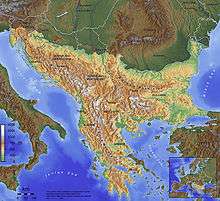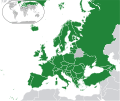North Macedonia
North Macedonia[lower-alpha 3] (before 2019, Macedonia), officially the Republic of North Macedonia,[lower-alpha 4] is a country in the Balkan Peninsula in Southeast Europe. It gained its independence in 1991 as one of the successor states of Yugoslavia. A landlocked country, North Macedonia has borders with Kosovo[lower-alpha 5] to the northwest, Serbia to the northeast, Bulgaria to the east, Greece to the south, and Albania to the west.[7] It constitutes approximately the northern third of the larger geographical region of Macedonia. The capital and largest city, Skopje, is home to roughly a quarter of the country's 2.06 million inhabitants. The majority of the residents are ethnic Macedonians, a South Slavic people. Albanians form a significant minority at around 25%, followed by Turks, Romani, Serbs, Bosniaks, and Aromanians.
Republic of North Macedonia | |
|---|---|
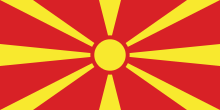 Flag
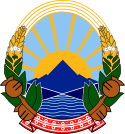 Emblem
| |
Anthem: Денес над Македонија (Macedonian) (English: "Today over Macedonia") | |
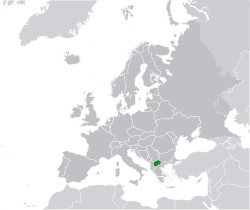 | |
| Capital and largest city | Skopje 42°0′N 21°26′E |
| Official languages | |
| |
| Ethnic groups (2002) |
|
| Demonym(s) |
|
| Government | Unitary parliamentary republic |
| Stevo Pendarovski | |
• Prime Minister | Oliver Spasovski |
• Chairman of the Assembly | Talat Xhaferi |
| Legislature | Assembly |
| History | |
| 8 September 1991 | |
• Admitted to United Nations | 8 April 1993 |
| 12 February 2019 | |
• Joined NATO | 27 March 2020 |
| Area | |
• Total | 25,713 km2 (9,928 sq mi) (145th) |
• Water (%) | 1.9 |
| Population | |
• 2019 estimate | |
• 2002 census | 2,022,547[2] |
• Density | 80.1/km2 (207.5/sq mi) (122nd) |
| GDP (PPP) | 2019 estimate |
• Total | $33.822 billion[4] |
• Per capita | $16,253[4] |
| GDP (nominal) | 2019 estimate |
• Total | $12.383 billion[4] |
• Per capita | $6,143[4] |
| Gini (2018) | medium |
| HDI (2018) | high · 82nd |
| Currency | Macedonian denar (MKD) |
| Time zone | UTC+1 (CET) |
| UTC+2 (CEST) | |
| Date format | dd.mm.yyyy (AD) |
| Driving side | right |
| Calling code | +389 |
| ISO 3166 code | MK |
| Internet TLD |
|
The history of the region dates back to antiquity, beginning with the kingdom of Paeonia, presumably a mixed Thraco-Illyrian polity.[8] In the late sixth century BC, the area was incorporated into the Persian Achaemenid Empire, then annexed by the kingdom of Macedonia in the fourth century BC. The Romans conquered the region in the second century BC and made it part of the much larger province of Macedonia. The area remained part of the Byzantine Empire, but was often raided and settled by Slavic tribes beginning in the sixth century of the Christian era. Following centuries of contention between the Bulgarian, Byzantine, and Serbian Empire, it was part of the Ottoman dominion from the mid-14th until the early 20th century, when, following the Balkan Wars of 1912 and 1913, the modern territory of North Macedonia came under Serbian rule.
During the First World War (1915–1918), it was ruled by Bulgaria, but after the end of the war it returned to being under Serbian rule as part of the newly formed Kingdom of Serbs, Croats and Slovenes. Later, during the Second World War (1941–1944), it was ruled by Bulgaria again, and in 1945 it was established as a constituent state of communist Yugoslavia, which it remained until its peaceful secession in 1991. The country became a member of the United Nations in April 1993, but as a result of a dispute with Greece over the name "Macedonia", it was admitted under the provisional description the former Yugoslav Republic of Macedonia[lower-alpha 6] (abbreviated as FYR Macedonia and FYROM). In June 2018, Macedonia and Greece resolved the conflict with an agreement that the country should rename itself "Republic of North Macedonia". This renaming came into effect in February 2019.
A unitary parliamentary constitutional republic, North Macedonia is a member of the UN, NATO, Council of Europe, World Bank, OSCE, CEFTA, and the WTO. Since 2005, it has also been a candidate for joining the European Union. North Macedonia is an upper-middle-income country[11] and has undergone considerable economic reform since independence in developing an open economy. North Macedonia is a developing country, ranking 82nd on the Human Development Index, and provides a social security, universal health care system, and free primary and secondary education to its citizens.
Names and etymology
The state's name derives from the Greek word Μακεδονία (Makedonía),[12][13] a kingdom (later, region) named after the ancient Macedonians. Their name, Μακεδόνες (Makedónes), derives ultimately from the ancient Greek adjective μακεδνός (makednós), meaning tall or taper,[14] which shares the same root as the adjective μακρός (makrós), meaning long, tall, or high, in ancient Greek.[15] The name is believed to have originally meant either highlanders or the tall ones, possibly descriptive of the people.[13][16][17] According to linguist Robert S. P. Beekes, both terms are of Pre-Greek substrate origin and cannot be explained in terms of Indo-European morphology;[18] however, linguist Filip De Decker argues the arguments are insufficient.[19]
In the early 19th century the name of Macedonia was almost unknown in the modern-day area.[20][21][22] It was revived only in middle of the century, with rise of nationalism in the Ottoman Empire.[23][24][25] In the early 20th century the region was already a national cause, contested among Bulgarian, Greek and Serbian nationalists. During the interwar period the use of the name Macedonia was prohibited in the Kingdom of Yugoslavia, due to the implemented policy of Serbianization of the local Slavs.[26][27] The name Macedonia was adopted officially for the first time at the end of the Second World War by the new Socialist Republic of Macedonia, which became one of the six constituent countries of the Socialist Federal Republic of Yugoslavia. After the fall of Communism, with the beginning of the breakup of Yugoslavia, this federal entity declared independence and changed its official name to Republic of Macedonia in 1991. Prior to June 2018, the use of the name Macedonia was disputed between Greece and the then-Republic of Macedonia.
The Prespa agreement saw the country change its name to the Republic of North Macedonia eight months later.[28][29] A non-binding[30] national referendum on the matter passed with 90% approval but did not reach the required 50% turnout amidst a boycott, leaving the final decision with parliament to ratify the result.[31] Parliament approved of the name change on 19 October, reaching the required two-thirds majority needed to enact constitutional changes.[32] The vote to amend the constitution and change the name of the country passed on 11 January 2019 in favour of the amendment.[33] The amendment entered into force on 12 February, following the ratification of the Prespa agreement and the Protocol on the Accession of North Macedonia to NATO by the Greek Parliament.[34] Despite the renaming, the country is still unofficially discussed as 'Macedonia' by its citizens and most of the local media.
History
Ancient and Roman periods
.svg.png)
North Macedonia geographically roughly corresponds to the ancient kingdom of Paeonia,[35][36][37][38] which was located immediately north of the ancient kingdom of Macedonia.[39] Paeonia was inhabited by the Paeonians, a Thracian people,[40] whilst the northwest was inhabited by the Dardani and the southwest by tribes known historically as the Enchelae, Pelagones, and Lyncestae; the latter two are generally regarded as Molossian tribes of the northwestern Greek group, whilst the former two are considered Illyrian.[41][42][43][44][45][46]
In the late 6th century BC, the Achaemenid Persians under Darius the Great conquered the Paeonians, incorporating what is today the state of North Macedonia within their vast territories.[47][48][49] Following the loss in the Second Persian invasion of Greece in 479 BC, the Persians eventually withdrew from their European territories, including from what is today North Macedonia.
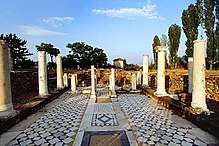
Philip II of Macedon absorbed[50] the regions of Upper Macedonia (Lynkestis and Pelagonia) and the southern part of Paeonia (Deuriopus) into the kingdom of Macedon in 356 BC.[51] Philip's son Alexander the Great conquered the remainder of the region and incorporated it in his empire, reaching as far north as Scupi, but the city and the surrounding area remained part of Dardania.[52]
The Romans established the province of Macedonia in 146 BC. By the time of Diocletian, the province had been subdivided between Macedonia Prima ("first Macedonia") on the south, encompassing most of the kingdom of Macedon, and Macedonia Salutaris (meaning "wholesome Macedonia", known also as Macedonia Secunda, "second Macedonia") on the north, encompassing partially Dardania and the whole of Paeonia; most of the country's modern boundaries fell within the latter, with the city of Stobi as its capital.[53] Roman expansion brought the Scupi area under Roman rule in the time of Domitian (81–96 AD), and it fell within the Province of Moesia.[54] Whilst Greek remained the dominant language in the eastern part of the Roman empire, Latin spread to some extent in Macedonia.[55]
Medieval and Ottoman periods
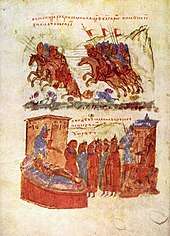
Slavic tribes settled in the Balkan region including North Macedonia by the late 6th century AD. During the 580s, Byzantine literature attests to the Slavs raiding Byzantine territories in the region of Macedonia, later aided by Bulgars. Historical records document that in c. 680 a group of Bulgars, Slavs and Byzantines led by a Bulgar called Kuber settled in the region of the Keramisian plain, centred on the city of Bitola, forming a second route for the Bulgar definitive settlement on the Balkan Peninsula at the end of the 7th century.[56] Presian's reign apparently coincides with the extension of Bulgarian control over the Slavic tribes in and around Macedonia. The Slavic tribes that settled in the region of Macedonia converted to Christianity around the 9th century during the reign of Tsar Boris I of Bulgaria. The Ohrid Literary School became one of the two major cultural centres of the First Bulgarian Empire, along with the Preslav Literary School. Established in Ohrid in 886 by Saint Clement of Ohrid on the order of Boris I, the Ohrid Literary School was involved in the spreading of the Cyrillic script.[57]
.jpg)
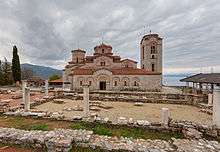
After Sviatoslav's invasion of Bulgaria, the Byzantines took control of East Bulgaria. Samuil, one of the Cometopuli brothers, was proclaimed Tsar of Bulgaria. He moved the capital to Skopje and then to Ohrid, which had been the cultural and military centre of southwestern Bulgaria since Boris I's rule. Samuil reestablished Bulgarian power, but after several decades of conflicts, in 1014, the Byzantine Emperor Basil II defeated his armies, and within four years the Byzantines restored control over the Balkans (including North Macedonia) for the first time since the 7th century. The rank of the autocephalous Bulgarian Patriarchate was lowered due to its subjugation to Constantinople and it was transformed into the Archbishopric of Ohrid. By the late 12th century, Byzantine decline saw the region contested by various political entities, including a brief Norman occupation in the 1080s.
In the early 13th century, a revived Bulgarian Empire gained control of the region. Plagued by political difficulties, the empire did not last, and the region came once again under Byzantine control in the early 14th century. In the 14th century, it became part of the Serbian Empire, who saw themselves as liberators of their Slavic kin from Byzantine despotism. Skopje became the capital of Tsar Stefan Dusan's empire.
Following Dusan's death, a weak successor appeared, and power struggles between nobles divided the Balkans once again. These events coincided with the entry of the Ottoman Turks into Europe. The Kingdom of Prilep was one of the short-lived states that emerged from the collapse of the Serbian Empire in the 14th century.[58] Gradually, all of the central Balkans were conquered by the Ottoman Empire and remained under its domination for five centuries as part of the province or Eyalet of Rumelia. The name Rumelia (Turkish: Rumeli) means "Land of the Romans" in Turkish, referring to the lands conquered by the Ottoman Turks from the Byzantine Empire.[59]). Over the centuries Rumelia Eyalet was reduced in size through administrative reforms, until by the nineteenth century it consisted of a region of central Albania and western North Macedonia with its capital at Manastir or present day Bitola.[60] Rumelia Eyalet was abolished in 1867 and that territory of Macedonia subsequently became part of the province of Manastir Vilayet until the end of Ottoman rule in 1912.
Macedonian separatism
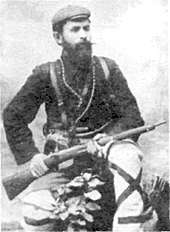
With the beginning of the Bulgarian National Revival in the 18th century, many of the reformers were from this region, including the Miladinov Brothers,[61] Rajko Žinzifov, Joakim Krčovski,[62] Kiril Pejčinoviḱ[63] and others. The bishoprics of Skopje, Debar, Bitola, Ohrid, Veles, and Strumica voted to join the Bulgarian Exarchate after it was established in 1870.[64]
Several movements whose goals were the establishment of an autonomous Macedonia, which would encompass the entire region of Macedonia, began to arise in the late 19th century; the earliest of these was the Bulgarian Macedonian-Adrianople Revolutionary Committees, later becoming Secret Macedonian-Adrianople Revolutionary Organization (SMARO). In 1905 it was renamed the Internal Macedonian-Adrianople Revolutionary Organization (IMARO), and after World War I the organisation separated into the Internal Macedonian Revolutionary Organization (IMRO) and the Internal Thracian Revolutionary Organisation (ITRO).[65]
In the early years of the organisation, membership eligibility was exclusive to Bulgarians, but later it was extended to all inhabitants of European Turkey regardless of ethnicity or religion.[66] The majority of its members were Macedonian Bulgarians.[67] In 1903, IMRO organised the Ilinden-Preobrazhenie Uprising against the Ottomans, which after some initial successes, including the forming of the Kruševo Republic, was crushed with much loss of life.[68] The uprising and the forming of the Kruševo Republic are considered the cornerstone and precursors to the eventual establishment of the Macedonian state.[69][70][71] The leaders of the Ilinden uprising are celebrated as national heroes in North Macedonia. The names of IMRO revolutionaries like Gotse Delchev, Pitu Guli, Dame Gruev and Yane Sandanski were included into the lyrics of the national anthem of the state of North Macedonia "Denes nad Makedonija" ("Today over Macedonia"). The major national holiday of North Macedonia, the Republic Day, is celebrated on 2 August, Ilinden (St. Elijah day), the day of the Ilinden uprising.
Kingdoms of Serbia and Yugoslavia
Following the two Balkan Wars of 1912 and 1913 and the dissolution of the Ottoman Empire, most of its European-held territories were divided between Greece, Bulgaria and Serbia.[72] The territory that was to become North Macedonia was annexed by Serbia and named South Serbia. Following the partition, an anti-Bulgarian campaign was carried out in the areas under Serbian and Greek control.[73] As many as 641 Bulgarian schools and 761 churches were closed by the Serbs, while Exarchist clergy and teachers were expelled.[73] The use of all Macedonian dialects and standard Bulgarian were proscribed.[73] IMRO, together with local Albanians, organised the Ohrid–Debar uprising against the Serbian rule. Within a few days the rebels captured the towns of Gostivar, Struga and Ohrid, expelling the Serbian troops. According to the Carnegie Endowment for International Peace report, a Serbian army of 100,000 regulars suppressed the uprising. Many were killed and tens of thousands refugees fled to Bulgaria and Albania.[74][75]
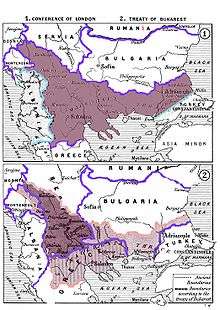
In the fall of 1915, Bulgaria joined the Central Powers in the First World War and occupied most of today's North Macedonia.[73] After the end of the First World War, the area returned to Serbian control as part of the newly formed Kingdom of Serbs, Croats and Slovenes[76] and saw a reintroduction of the anti-Bulgarian measures. Bulgarian teachers and clergy were expelled, Bulgarian language signs and books removed, and all Bulgarian organisations dissolved.[73]
The Serbian government pursued a policy of forced Serbianisation in the region,[77][78] which included systematic suppression of Bulgarian activists, altering family surnames, internal colonisation, forced labour, and intense propaganda.[79] To aid the implementation of this policy, some 50,000 Serbian army and gendermerie were stationed in North Macedonia.[73] By 1940 about 280 Serbian colonies (comprising 4,200 families) were established as part of the government's internal colonisation program (initial plans envisaged 50,000 families settling in North Macedonia).[73]
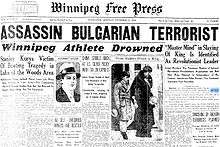
In 1929, the Kingdom was officially renamed the Kingdom of Yugoslavia, and divided into provinces called banovinas. South Serbia, including all of what is now the state of North Macedonia, became the Vardar Banovina of the Kingdom of Yugoslavia.[83]
The Internal Macedonian Revolutionary Organization (IMRO) promoted the concept of an Independent Macedonia in the interbellum. Its leaders – including Todor Alexandrov, Aleksandar Protogerov, and Ivan Mihailov – promoted independence of the Macedonian territory split between Serbia and Greece for the whole population, regardless of religion and ethnicity.[84] The Bulgarian government of Alexander Malinov in 1918 offered to give Pirin Macedonia for that purpose after World War I,[85] but the Great Powers did not adopt this idea because Serbia and Greece opposed it. In 1924, the Communist International suggested that all Balkan communist parties adopt a platform of a "United Macedonia" but the suggestion was rejected by the Bulgarian and Greek communists.[86]
IMRO followed by starting an insurgent war in Vardar Macedonia, together with Macedonian Youth Secret Revolutionary Organization, which also conducted guerrilla attacks against the Serbian administrative and army officials there. In 1923 in Stip, a paramilitary organisation called Association against Bulgarian Bandits was formed by Serbian chetniks, IMRO renegades and Macedonian Federative Organization (MFO) members to oppose IMRO and MMTRO.[87] On 9 October 1934 IMRO member Vlado Chernozemski assassinated Alexander I of Yugoslavia.
The Macedonist ideas increased in Yugoslav Vardar Macedonia and among the left diaspora in Bulgaria during the interbellum. They were supported by the Comintern.[88] In 1934, the Comintern issued a special resolution in which for the first time directions were provided for recognising the existence of a separate Macedonian nation and Macedonian language.[89]
World War II period
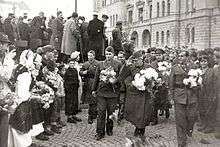
During World War II, Yugoslavia was occupied by the Axis powers from 1941 to 1945. The Vardar Banovina was divided between Bulgaria and Italian-occupied Albania. Bulgarian Action Committees were established to prepare the region for the new Bulgarian administration and army.[90] The committees were mostly formed by former members of IMRO and MYSRO, but some IMRO (United) former members also participated.[91][92]
As leader of the Vardar Macedonian communists, Shatorov switched from the Yugoslav Communist Party to the Bulgarian Communist Party[92][93] and refused to start military action against the Bulgarian Army.[94] The Bulgarian authorities, under German pressure,[95] were responsible for the round-up and deportation of over 7,000 Jews in Skopje and Bitola.[96] Harsh rule by the occupying forces encouraged many Vardar Macedonians to support the Communist Partisan resistance movement of Josip Broz Tito after 1943,[lower-alpha 7] and the National Liberation War ensued.[97][98]
In Vardar Macedonia, after the Bulgarian coup d'état of 1944, the Bulgarian troops, surrounded by German forces, fought their way back to the old borders of Bulgaria.[99] Under the leadership of the new Bulgarian pro-Soviet government, four armies, 455,000 strong in total, were mobilised and reorganised. Most of them re-entered occupied Yugoslavia in early October 1944 and moved from Sofia to Niš, Skopje and Pristina with the strategic task of blocking the German forces withdrawing from Greece.[100] The Bulgarian army would reach the Alps in Austria, participating in the expulsion of the Germans to the west, through Yugoslavia and Hungary.
Compelled by the Soviet Union with a view towards the creation of a large South Slav Federation, the Bulgarian government, led by Georgi Dimitrov, once again offered to give Pirin Macedonia to such a United Macedonia in 1945. Creation of a distinct Macedonian nation within the new country and a separate Macedonian language were part of the Bled agreement. After the Tito–Stalin Split the region of Pirin Macedonia remained part of Bulgaria and later the Bulgarian Communist Party revised its view of existence of a separate Macedonian nation and language.
Socialist Yugoslavia period
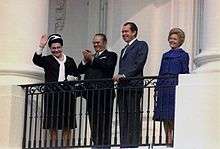
In December 1944 the Anti-Fascist Assembly for the National Liberation of Macedonia (ASNOM) proclaimed the People's Republic of Macedonia as part of the People's Federal Republic of Yugoslavia.[101] ASNOM remained an acting government until the end of the war. The Macedonian alphabet was codified by linguists of ASNOM, who based their alphabet on the phonetic alphabet of Vuk Stefanović Karadžić and the principles of Krste Petkov Misirkov. During the civil war in Greece (1946–1949), Macedonian communist insurgents supported the Greek communists. Many refugees fled to the Socialist Republic of Macedonia from there. The state dropped Socialist from its name in 1991 when it peacefully seceded from Yugoslavia.
The new republic became one of the six republics of the Yugoslav federation. Following the federation's renaming as the Socialist Federal Republic of Yugoslavia in 1963, the People's Republic of Macedonia was likewise renamed the Socialist Republic of Macedonia.[102][103][104]
Declaration of independence
North Macedonia officially celebrates 8 September 1991 as Independence day (Macedonian: Ден на независноста, Den na nezavisnosta), with regard to the referendum endorsing independence from Yugoslavia.[105] The anniversary of the start of the Ilinden Uprising (St. Elijah's Day) on 2 August is also widely celebrated on an official level as the Day of the Republic.
Robert Badinter, as the head of the Arbitration Commission of the Peace Conference on Yugoslavia, recommended EC recognition in January 1992.[106]
North Macedonia remained at peace through the Yugoslav Wars of the early 1990s. A few very minor changes to its border with Yugoslavia were agreed upon to resolve problems with the demarcation line between the two countries. It was seriously destabilised by the Kosovo War in 1999, when an estimated 360,000 ethnic Albanian refugees from Kosovo took refuge in the country.[107] They departed shortly after the war, and Albanian nationalists on both sides of the border took up arms soon after in pursuit of autonomy or independence for the Albanian-populated areas of North Macedonia.[107][108]
2001 insurgency
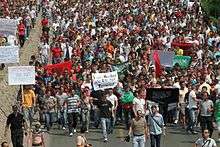
A conflict took place between the government and ethnic Albanian insurgents, mostly in the north and west of the country, between February and August 2001.[108][109][110] The war ended with the intervention of a NATO ceasefire monitoring force. Under the terms of the Ohrid Agreement, the government agreed to devolve greater political power and cultural recognition to the Albanian minority.[111] The Albanian side agreed to abandon separatist demands and to recognise all Macedonian institutions fully. In addition, according to this accord, the NLA were to disarm and hand over their weapons to a NATO force.[112]
Inter-ethnic tensions flared in North Macedonia in 2012, with incidents of violence between ethnic Albanians and Macedonians.[113]
Antiquisation policy
Since the coming to power in 2006, and especially since the country's non-invitation to NATO in 2008, the VMRO-DPMNE government pursued a policy of "Antiquisation" ("Antikvizatzija") as a way of putting pressure on Greece as well as for the purposes of domestic identity-building.[114] Statues of Alexander the Great and Philip of Macedon have been built in several cities across the country. Additionally, many pieces of public infrastructure, such as airports, highways, and stadiums were renamed after Alexander and Philip. These actions were seen as deliberate provocations in neighbouring Greece, exacerbating the dispute and further stalling the country's EU and NATO applications.[115] The policy has also attracted criticism domestically, as well as from EU diplomats,[114] and, following the Prespa Agreement, it has been partly reversed after 2016 by the new SDSM government of North Macedonia.[116][117]
Prespa agreement, NATO accession, and EU path
The Prespa agreement, which replaces the Interim Accord of 1995,[118] was signed on 17 June 2018 in a high-level ceremony at the Greek border village of Psarades on Lake Prespa, by the two foreign ministers Nikola Dimitrov and Nikos Kotzias and in the presence of the respective prime ministers, Zoran Zaev and Alexis Tsipras.[119][120][121][122] The meeting was attended by the UN's Special Representative Matthew Nimetz, the U.S. Under-Secretary-General for Political Affairs Rosemary DiCarlo, the EU's High Representative of the Union for Foreign Affairs and Security Policy Federica Mogherini, and the European Commissioner for Enlargement and European Neighbourhood Policy Johannes Hahn, among others.[123] After the ceremony, Tsipras and Zaev travelled across the border to the village of Oteševo on the other side of the lake. It was a highly symbolic move that marked the first time a Greek Prime Minister had entered the country since its independence in 1991.[124][125]
The withdrawal of the Greek veto resulted in the European Union on 27 June approving the start of accession talks with the Republic of Macedonia, which were expected to take place in 2019, under the condition that the Prespa deal was implemented and the country's name was changed to Republic of North Macedonia.[126] On 5 July, the Prespa agreement was ratified again by the Macedonian parliament with 69 MPs voting in favour of it.[127] On 12 July, NATO invited Macedonia to start accession talks in a bid to become the EuroAtlantic alliance's 30th member.[128] On 30 July, the parliament of Macedonia approved plans to hold a non-binding referendum on changing the country's name, which took place on 30 September.[129] 91% of voters voted in favour with a 37% turnout,[130] but the referendum was not carried because of a constitutional requirement for a 50% turnout.[131]
As stipulated in the Prespa agreement, the government moved forward with the name changing process in the Macedonian parliament.[132] On 15 October, the parliament of Macedonia began debating the name change.[133] The proposal for the constitutional amendments required the vote of 80 MPs, i.e. two-thirds of the 120-seat parliament.[134][135]
On 19 October 2018 the Macedonian parliament voted to start the process of renaming the country after a total of 80 MPs voted in favour of the constitutional changes.[136] On 11 January 2019, the Macedonian parliament approved the constitutional amendments required by the Prespa Agreement by 81 deputies voting for out of 120.[137] On 25 January, the Greek parliament ratified the Prespa Agreement with 153 votes in favour, 146 against, and 1 abstaining.[138]
On 6 February 2019, the permanent representatives of NATO member states and Macedonian Foreign Affairs Minister Nikola Dimitrov, signed in Brussels the accession protocol of North Macedonia into NATO.[139][140] The protocol was then ratified on 8 February by the Greek parliament, thus completing all the preconditions for putting into force the Prespa agreement. Subsequently, on 12 February the Macedonian government announced the formal activation of the constitutional amendments which effectively renamed the country as North Macedonia and informed accordingly the United Nations and its member states.[141][142]
Prime Ministers Zoran Zaev and Alexis Tsipras have received international praise for realising the Prespa agreement. On 16 February 2019, at the Munich Security Conference, they received the 'Ewald von Kleist Award',[143] and have also been nominated for the Nobel Peace Prize by senior members of the European Parliament.[144]
In March 2020, after the ratification process by all NATO members was completed, North Macedonia acceded to NATO, becoming the 30th member state.[145][146] The same month, the leaders of the European Union formally gave approval to North Macedonia begin talks to join the EU.[147][148]
Geography
Location
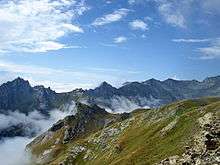
North Macedonia has a total area of 25,713 km2 (9,928 sq mi). It lies between latitudes 40° and 43° N, and mostly between longitudes 20° and 23° E (a small area lies east of 23°). North Macedonia has some 748 km (465 mi) of boundaries, shared with Serbia (62 km or 39 mi) to the North, Kosovo (159 km or 99 mi) to the northwest, Bulgaria (148 km or 92 mi) to the east, Greece (228 km or 142 mi) to the south, and Albania (151 km or 94 mi) to the west. It is a transit way for shipment of goods from Greece, through the Balkans, towards Eastern, Western and Central Europe and through Bulgaria to the east. It is part of the larger region of Macedonia, which also includes Macedonia (Greece) and the Blagoevgrad Province in southwestern Bulgaria.
North Macedonia is a landlocked country that is geographically clearly defined by a central valley formed by the Vardar river and framed along its borders by mountain ranges. The terrain is mostly rugged, located between the Šar Mountains and Osogovo, which frame the valley of the Vardar river. Three large lakes – Lake Ohrid, Lake Prespa and Dojran Lake – lie on the southern borders, bisected by the frontiers with Albania and Greece. Ohrid is considered to be one of the oldest lakes and biotopes in the world.[149] The region is seismically active and has been the site of destructive earthquakes in the past, most recently in 1963 when Skopje was heavily damaged by a major earthquake, killing over 1,000.
North Macedonia also has scenic mountains. They belong to two different mountain ranges: the first is the Šar Mountains[150][151] that continues to the West Vardar/Pelagonia group of mountains (Baba Mountain, Nidže, Kozuf and Jakupica), also known as the Dinaric range. The second range is the Osogovo–Belasica mountain chain, also known as the Rhodope range. The mountains belonging to the Šar Mountains and the West Vardar/Pelagonia range are younger and higher than the older mountains of the Osogovo-Belasica mountain group. Mount Korab of the Šar Mountains on the Albanian border, at 2,764 m (9,068 ft), is the tallest mountain in North Macedonia.
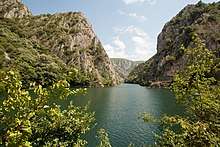
In North Macedonia there are 1,100 large sources of water. The rivers flow into three different basins: the Aegean, the Adriatic and the Black Sea.[152]
The Aegean basin is the largest. It covers 87% of the territory of North Macedonia, which is 22,075 square kilometres (8,523 sq mi). Vardar, the largest river in this basin, drains 80% of the territory or 20,459 square kilometres (7,899 sq mi). Its valley plays an important part in the economy and the communication system of the country. The Vardar Valley project is considered to be crucial for the strategic development of the country.
The river Black Drin forms the Adriatic basin, which covers an area of about 3,320 km2 (1,282 sq mi), i.e., 13% of the territory. It receives water from Lakes Prespa and Ohrid.
The Black Sea basin is the smallest with only 37 km2 (14 sq mi). It covers the northern side of Mount Skopska Crna Gora. This is the source of the river Binachka Morava, which joins the Morava, and later, the Danube, which flows into the Black Sea.
North Macedonia has around fifty ponds and three natural lakes, Lake Ohrid, Lake Prespa and Lake Dojran.
In North Macedonia there are nine spa towns and resorts: Banište, Banja Bansko, Istibanja, Katlanovo, Kežovica, Kosovrasti, Banja Kočani, Kumanovski Banji and Negorci.
Climate

Four different seasons are found in the country with warm and dry summers and moderately cold and snowy winters. The range of temperatures recorded throughout the year ranges from −20 °C (−4 °F) in winter, to 40 °C (104 °F) in summer. The low winter temperatures are influenced by winds from the north while the heat seasons during the summer are due to the subtropical pression of the Aegean Sea and the influences of the Middle East, with the latter influences being responsible for the dry periods to be found in the country.[153] There are three main climatic zones in the country: mildly continental in the north, temperate Mediterranean in the south and mountain climate in the zones with high altitude.[154] Along the valleys of the Vardar and Strumica rivers, in the regions of Gevgelija, Valandovo, Dojran, Strumica, and Radoviš, the climate is temperate Mediterranean. The warmest regions are Demir Kapija and Gevgelija, where the temperature in July and August frequently exceeds 40 °C (104 °F).[155]
Average annual precipitation varies from 1,700 mm (66.9 in) in the western mountainous area to 500 mm (19.7 in) in the eastern area. There is a low level of precipitation in the Vardar valley with 500 mm (19.7 in) of water per yer.[153] The climate and irrigation diversity allow the cultivation of different plant types, including wheat, corn, potatoes, poppies, peanuts, and rice.[156] There are thirty main and regular weather stations in the country.
Biodiversity
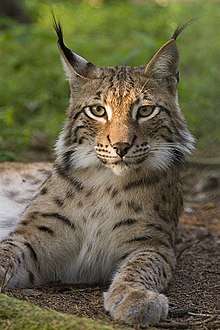
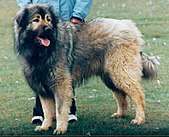
The flora of North Macedonia is represented by around 210 families, 920 genera, and around 3,700 plant species. The most abundant group are the flowering plants with around 3,200 species, followed by mosses (350 species) and ferns (42).
Phytogeographically, North Macedonia belongs to the Illyrian province of the Circumboreal Region within the Boreal Kingdom. According to the World Wide Fund for Nature (WWF) and the Digital Map of European Ecological Regions by the European Environment Agency, the territory of the Republic can be subdivided into four ecoregions: the Pindus Mountains mixed forests, Balkan mixed forests, Rhodopes mixed forests and Aegean sclerophyllous and mixed forests.
National Park of Pelister in Bitola is known for the presence of the endemic Macedonian Pine, as well as some 88 species of plants representing almost 30 percent of North Macedonian dendroflora. The Macedonian Pine forests on Pelister are divided into two communities: pine forests with ferns and pine forests with junipers. The Macedonian Pine, as a specific conifer species, is a relict of tertiary flora, and the five-needle pine Molika, was first noted on Pelister in 1893.
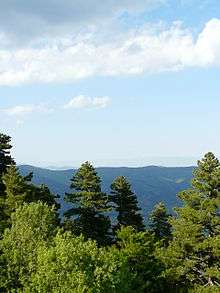
North Macedonia's limited forest growth also includes Macedonian Oaks, the sycamore, weeping willows, white willows, alders, poplars, elms, and the common ash. Near the rich pastures on Šar Mountain and Bistra, Mavrovo, is another plant species characteristic of plant life in Macedonia – the poppy. The quality of thick poppy juice is measured worldwide by morphine units; while Chinese opium contains eight such units and is considered to be of high quality, Indian opium contains seven units, and Turkish opium only six, Macedonian opium contains a full 14 morphine units and is one of the best quality opiums in the world.[157]
The native forest fauna is abundant and includes bears, wild boars, wolves, foxes, squirrels, chamois and deer. The lynx is found, very rarely, in the mountains of western Macedonia, while deer can be found in the region of Demir Kapija. Forest birds include the blackcap, the grouse, the black grouse, the imperial eagle and the forest owl.
The three artificial lakes of the country represent a separate fauna zone, an indication of long-lasting territorial and temporal isolation. The fauna of Lake Ohrid is a relict of an earlier era and the lake is widely known for its letnica trout, lake whitefish, gudgeon, roach, podust, and pior, as well as for certain species of snails of a genus older than 30 million years; similar species can be found only in Lake Baikal. Lake Ohrid is also noted in zoology texts for the European eel and its baffling reproductive cycle: it comes to Lake Ohrid from the distant Sargasso Sea,[158][159] thousands of kilometres away, and lurks in the depths of the lake for 10 years. When sexually mature, the eel is driven by unexplained instincts in the autumn to set off back to its point of birth. There it spawns and dies, leaving its offspring to seek out Lake Ohrid to begin the cycle anew.[159]
The shepherd dog of Šar Mountain, the Šarplaninec (Yugoslav shepherd), is known worldwide.[160][lower-alpha 8][161] It stands some 60 centimetres (2.0 ft) tall[160] and is a brave and fierce fighter that may be called upon to fight bears or wolf packs while guarding and defending flocks. The Šarplaninec originates from the shepherd's dog of the ancient Epirotes, the molossus, but it was recognised as its own breed in 1939 under the name of Illyrian shepherd and since 1956 has been known as Šarplaninec.[lower-alpha 8][160][161]
The country has three national parks:
| Name | Established | Size | Map | Picture |
|---|---|---|---|---|
| Mavrovo | 1948 | 731 km2 |
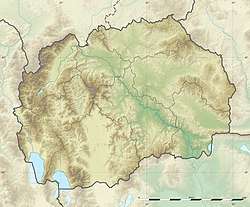 |
 |
| Galičica | 1958 | 227 km2 |
 |
 |
| Pelister | 1948 | 125 km2 |
 |
 |
Politics
.jpg)
North Macedonia is a parliamentary democracy with an executive government composed of a coalition of parties from the unicameral legislature (Собрание, Sobranie) and an independent judicial branch with a constitutional court. The Assembly is made up of 120 seats and the members are elected every four years. The role of the President of the Republic is mostly ceremonial, with the real power resting in the hands of the Prime Minister. The President is the commander-in-chief of the state armed forces and a president of the state Security Council. The President is elected every five years and he or she can be elected twice at most.
With the passage of a new law and elections held in 2005, local government functions are divided between 78 municipalities (општини, opštini; singular: општина, opština). The capital, Skopje, is governed as a group of ten municipalities collectively referred to as the "City of Skopje". Municipalities in North Macedonia are units of local self-government. Neighbouring municipalities may establish co-operative arrangements.
The country's main political divergence is between the largely ethnically based political parties representing the country's ethnic Macedonian majority and Albanian minority. The issue of the power balance between the two communities led to a brief war in 2001, following which a power-sharing agreement was reached. In August 2004, parliament passed legislation redrawing local boundaries and giving greater local autonomy to ethnic Albanians in areas where they predominate.
After a troublesome pre-election campaign, North Macedonia saw a relatively calm and democratic change of government in the elections held on 5 July 2006. The elections were marked by a decisive victory of the centre-right party VMRO-DPMNE led by Nikola Gruevski. Gruevski's decision to include the Democratic Party of Albanians in the new government, instead of the Democratic Union for Integration – Party for Democratic Prosperity coalition which won the majority of the Albanian votes, triggered protests throughout the parts of the country with a respective number of Albanian population. A dialogue was later established between the Democratic Union for Integration and the ruling VMRO-DMPNE party as an effort to talk about the disputes between the two parties and to support European and NATO aspirations of the country.[162]
After the early parliamentary elections held in 2008, VMRO-DPMNE and Democratic Union for Integration formed a ruling coalition.[163]
In April 2009, presidential and local elections in the country were carried out peacefully, which was crucial for Macedonian aspirations to join the EU.[164] The ruling conservative VMRO-DPMNE party won a victory in the local elections and the candidate supported by the party, Gjorgi Ivanov, was elected as the new president.
As of 4 January 2020, the acting Prime Minister of North Macedonia is Oliver Spasovski and the current President of the Parliament is Talat Xhaferi.[165] The election of Xhaferi was immediately met with protests led by VMRO-DPMNE, which was quickly handled by the police.[165]
Governance
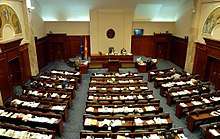
Parliament, or Sobranie (Macedonian: Собрание), is the country's legislative body. It makes, proposes and adopts laws. The Constitution of North Macedonia has been in use since the formation of the republic in the 1993. It limits the power of the governments, both local and national. The military is also limited by the constitution. The constitution states that North Macedonia is a social free state, and that Skopje is the capital.[166] The 120 members are elected for a mandate of four years through a general election. Each citizen aged 18 years or older can vote for one of the political parties. The current president of Parliament is Talat Xhaferi.
Executive power in North Macedonia is exercised by the Government, whose prime minister is the most politically powerful person in the country. The members of the government are chosen by the Prime Minister and there are ministers for each branch of the society. There are ministers for economy, finance, information technology, society, internal affairs, foreign affairs and other areas. The members of the Government are elected for a mandate of four years. The current acting Prime Minister is Oliver Spasovski, whose term ends in April 2020.
Judiciary power is exercised by courts, with the court system being headed by the Judicial Supreme court, Constitutional Court and the Republican Judicial Council. The assembly appoints the judges.
Foreign relations
North Macedonia became a member state of the UN on 8 April 1993, eighteen months after its independence from Yugoslavia. It was referred to within the UN as "the former Yugoslav Republic of Macedonia", until the resolution of the long-running dispute with Greece about the country's name.
The major interest of the country is a full integration in the European and the Trans-Atlantic integration processes.[167] Five foreign policy priorities are:[168]
- Commencing negotiations for full-fledged membership in the European Union
- Lifting the visa regime for Macedonian nationals
- NATO membership
- Resolving the naming issue with Greece
- Strengthening the economic and public diplomacy
North Macedonia is a member of the following international and regional organisations:[169] IMF (since 1992), WHO (since 1993), EBRD (since 1993), Central European Initiative (since 1993), Council of Europe (since 1995), OSCE (since 1995), SECI (since 1996), La Francophonie (since 2001), WTO (since 2003), CEFTA (since 2006), NATO (since 2020).
In 2005, the country was officially recognised as a European Union candidate state.
At the NATO 2008 Bucharest summit, Macedonia failed to gain an invitation to join the organisation because Greece vetoed the move after the dispute over the name issue.[170] The U.S. had previously expressed support for an invitation,[171] but the summit then decided to extend an invitation only on condition of a resolution of the naming conflict with Greece.
In March 2009, the European Parliament expressed support for North Macedonia's EU candidacy and asked the EU Commission to grant the country a date for the start of accession talks by the end of 2009. The parliament also recommended a speedy lifting of the visa regime for Macedonian citizens.[172] Prior to the Prespa Agreement, the country failed to receive a start date for accession talks as a result of the naming dispute. However, after the Prespa Agreement, North Macedonia became a member state of NATO on 27 March 2020. The EU's stance was similar to NATO's in that resolution of the naming dispute was a precondition for the start of accession talks.
In October 2012, the EU Enlargement Commissioner Štefan Füle proposed a start of accession negotiations with the country for the fourth time, while the previous efforts were blocked each time by Greece. At the same time Füle visited Bulgaria in a bid to clarify the state's position with respect to Macedonia. He established that Bulgaria almost has joined Greece in vetoing the accession talks. The Bulgarian position was that Sofia cannot grant an EU certificate to Skopje, which is systematically employing an ideology of hate towards Bulgaria.[173]
Human rights
North Macedonia is a signatory to the European Convention on Human Rights and the U.N. Geneva Convention Relating to the Status of Refugees and Convention against Torture, and the Constitution guarantees basic human rights to all Macedonian citizens.
According to human rights organisations, in 2003 there were suspected extrajudicial executions, threats against, and intimidation of, human rights activists and opposition journalists, and allegations of torture by the police.[174][175]
Military
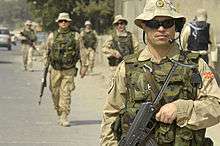
The military of North Macedonia comprises the army, air force, and special forces. The government's national defence policy aims to guarantee the preservation of the independence and sovereignty of the state, the integrity of its land area and airspace and its constitutional order. Its main goals remain the development and maintenance of a credible capability to defend the nation's vital interests and development of the Armed Forces in a way that ensures their interoperability with the armed forces of NATO and the European Union member states and their capability to participate in the full range of NATO missions.
The Ministry of Defence develops the Republic's defence strategy and assesses possible threats and risks. It is also responsible for the defence system, including training, readiness, equipment, and development, and for drawing up and presenting the defence budget.[176]
Naming dispute
.svg.png)
The use of the name "Macedonia" was disputed between Greece and North Macedonia, when the latter was known as the Republic of Macedonia. The specific naming dispute was reignited after the breakup of Yugoslavia and the newly gained independence of the former Socialist Republic of Macedonia in 1991.[177] Since then, it was an ongoing issue in bilateral and international relations until it was settled with the Prespa agreement in June 2018, the subsequent ratification by the Macedonian and Greek parliaments in late 2018 and early 2019, and the official renaming of Macedonia to North Macedonia in February 2019.
In the south, North Macedonia borders the region of Greek Macedonia, which administratively is split into three peripheries (one of them comprising both Western Thrace and a part of Greek Macedonia). Citing historical and territorial concerns resulting from the ambiguity between the then-Republic of Macedonia, the adjacent Greek region of Macedonia and the ancient Kingdom of Macedon which falls within Greek Macedonia, Greece opposed the use of the name Macedonia without a geographical qualifier such as "Northern Macedonia" for use "by all ... and for all purposes". (erga omnes).[178] As millions of ethnic Greeks identify themselves as Macedonians, unrelated to the Slavic people who are associated with North Macedonia, Greece further objected to the use of the term Macedonian for the neighbouring country's largest ethnic group. North Macedonia was accused of appropriating symbols and figures that are historically considered parts of Greece's culture (such as Vergina Sun, a symbol associated with the ancient Kingdom of Macedon, and Alexander the Great), and of promoting the irredentist concept of a United Macedonia, which would include territories of Greece, Bulgaria, Albania, and Serbia.[179]
From 1992 to 1995, the two countries engaged in a dispute over the Macedonian state's new flag, which incorporated the Vergina Sun symbol. This aspect of the dispute was resolved when the flag was changed under the terms of an interim accord agreed between the two states in October 1995.
.svg.png)
The UN adopted the provisional reference the former Yugoslav Republic of Macedonia (Macedonian: Поранешна Југословенска Република Македонија) when the country was admitted to the organisation in 1993.[180] The lower-cased "former" was chosen intentionally to display the provisionality of the name.[181] Most international organisations, such as the European Union, NATO, the European Broadcasting Union, and the International Olympic Committee, adopted the same convention.[182][183][184][185][186] However, most UN member countries soon abandoned the provisional reference and recognised the country as the Republic of Macedonia instead. These included four of the five permanent UN Security Council members: the United States,[187] Russia, the United Kingdom and the People's Republic of China; several members of the European Union such as Bulgaria, Poland, and Slovenia; and over 100 other UN members.[188] The UN set up a negotiating process with a mediator, Matthew Nimetz, and the two parties to the dispute to try to mediate the dispute.
Initially the European Community-nominated Arbitration Commission's opinion was that "the use of the name 'Macedonia' cannot therefore imply any territorial claim against another State";[189] despite the commission's opinion, Greece continued to object to the establishment of relations between the Community and the Republic under its constitutional name.[190]
In November 2008, the then-Republic of Macedonia instituted proceedings before the International Court of Justice (ICJ) against Greece alleging violations of the 1995 Interim Accord that blocked its accession to NATO.[191] The ICJ was requested to order Greece to observe its obligations within the Accord, which is legally binding for both countries. In 2011, The United Nations' International Court of Justice ruled that Greece violated Article 11 of the 1995 Interim Accord by vetoing Macedonia's bid for NATO membership at the 2008 summit in Bucharest.[192] However, the court did not consider it necessary to instruct Greece to refrain from similar actions in the future since "[a]s a general rule, there is no reason to suppose that a State whose act or conduct has been declared wrongful by the Court will repeat that act or conduct in the future, since its good faith must be presumed".[193] After the entering into force of the Prespa Agreement, Greece ratified the protocol for North Macedonia to join NATO, and actively supports North Macedonia's bid to join the EU.[194][195]
On 17 June 2018, the two countries signed an agreement to end their dispute, which would result in the Republic of Macedonia being renamed the Republic of North Macedonia (Република Северна Македонија).[196] On 30 July, the Macedonian parliament approved plans to hold a non-binding referendum on changing the country's name that took place on 30 September.[197] 91% of voters voted in favour with a 37% turnout,[198] On 11 January 2019, the Macedonian Parliament completed the legal implementation of the Prespa Agreement by approving the constitutional changes for renaming the country to North Macedonia with a two-thirds parliamentary majority (81 MPs).[199][200] On 25 January 2019, the Greek Parliament approved the Prespa agreement with 153 votes in favor and 146 votes against.[201]
Following the ratification of the Prespa Agreement, most major international organisations welcomed the settlement of the long-standing dispute, and adopted the country's new name.[202][203][204]
Administrative divisions
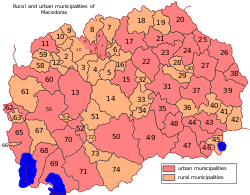
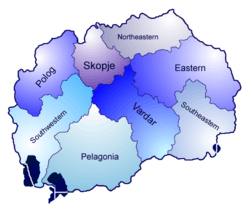
North Macedonia's statistical regions exist solely for legal and statistical purposes. The regions are:
- Eastern
- Northeastern
- Pelagonia
- Polog
- Skopje
- Southeastern
- Southwestern
- Vardar
In August 2004, the country was reorganised into 84 municipalities (opštini; sing. opština); 10 of the municipalities constitute the City of Skopje, a distinct unit of local self-government and the country's capital.
Most of the current municipalities were unaltered or merely amalgamated from the previous 123 municipalities established in September 1996; others were consolidated and their borders changed. Prior to this, local government was organised into 34 administrative districts, communes, or counties (also opštini).
Economy
Ranked as the fourth "best reformatory state" out of 178 countries ranked by the World Bank in 2009, North Macedonia has undergone considerable economic reform since independence.[205] The country has developed an open economy with trade accounting for more than 90% of GDP in recent years. Since 1996, North Macedonia has witnessed steady, though slow, economic growth with GDP growing by 3.1% in 2005. This figure was projected to rise to an average of 5.2% in the 2006–2010 period.[206] The government has proven successful in its efforts to combat inflation, with an inflation rate of only 3% in 2006 and 2% in 2007,[205] and has implemented policies focused on attracting foreign investment and promoting the development of small and medium-sized enterprises (SMEs).
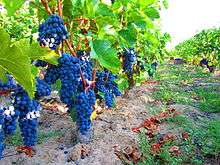
The current government introduced a flat tax system with the intention of making the country more attractive to foreign investment. The flat tax rate was 12% in 2007 and was further lowered to 10% in 2008.[207][208] Despite these reforms, as of 2005 North Macedonia's unemployment rate was 37.2%[209] and as of 2006 its poverty rate was 22%.[206] Due to a number of employment measures as well as the successful process of attracting multinational corporations, and according to the State Statistical Office of North Macedonia, the country's unemployment rate in the first quarter of 2015 decreased to 27.3%.[210] Government's policies and efforts in regards to foreign direct investments have resulted with the establishment of local subsidiaries of several world leading manufacturing companies, especially from the automotive industry, such as: Johnson Controls Inc., Van Hool NV, Johnson Matthey plc, Lear Corp., Visteon Corp., Kostal GmbH, Gentherm Inc., Dräxlmaier Group, Kromberg & Schubert, Marquardt GmbH, Amphenol Corp., Tekno Hose SpA, KEMET Corp., Key Safety Systems Inc., ODW-Elektrik GmbH, etc.
In terms of GDP structure, as of 2013 the manufacturing sector, including mining and construction constituted the largest part of GDP at 21.4%, up from 21.1% in 2012. The trade, transportation and accommodation sector represents 18.2% of GDP in 2013, up from 16.7% in 2012, while agriculture represents 9.6%, up from 9.1% in the previous year.[211]
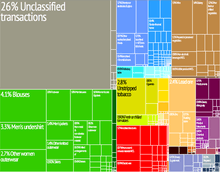
In terms of foreign trade, the largest sector contributing to the country's export in 2014 was "chemicals and related products" at 21.4%, followed by the "machinery and transport equipment" sector at 21.1%. North Macedonia's main import sectors in 2014 were "manufactured goods classified chiefly by material" with 34.2%, "machinery and transport equipment" with 18.7% and "mineral fuels, lubricants and related materials" with 14.4% of the total imports. Even 68.8% of the foreign trade in 2014 was done with the EU which makes the Union by far the largest trading partner of North Macedonia (23.3% with Germany, 7.9% with the UK, 7.3% with Greece, 6.2% with Italy, etc.). Almost 12% of the total external trade in 2014 was done with the Western Balkan countries.[212]
North Macedonia has one of the highest shares of people struggling financially, with 72% of its citizens stating that they could manage on their household's income only "with difficulty" or "with great difficulty", though North Macedonia, along with Croatia, was the only country in the Western Balkans to not report an increase in this statistic.[213] Corruption and a relatively ineffective legal system also act as significant restraints on successful economic development. North Macedonia still has one of the lowest per capita GDPs in Europe. Furthermore, the country's grey market is estimated at close to 20% of GDP.[214] PPS GDP per capita stood at 36% of the EU average in 2017.[215] With a GDP per capita of US$9,157 at purchasing power parity and a Human Development Index of 0.701, North Macedonia is less developed and has a considerably smaller economy than most of the former Yugoslav states.
Infrastructure and e-infrastructure
North Macedonia (along with Montenegro, Bosnia and Herzegovina and Kosovo) belongs to the less-developed southern region of the former Yugoslavia. It suffered severe economic difficulties after independence, when the Yugoslav internal market collapsed and subsidies from Belgrade ended. In addition, it faced many of the same problems faced by other former socialist East European countries during the transition to a market economy. Its main land and rail exports route, through Serbia, remains unreliable with high transit costs, thereby affecting the export of its formerly highly profitable, early vegetables market to Germany.
North Macedonia's IT market increased 63.8% year on year in 2007, which was the fastest growing in the Adriatic region.[216]
Trade and investment
The outbreak of the Yugoslav wars and the imposition of sanctions on Serbia and Montenegro caused great damage to the country's economy, with Serbia constituting 60% of its markets before the disintegration of Yugoslavia. When Greece imposed a trade embargo on the Republic in 1994–95, the economy was also affected. Some relief was afforded by the end of the Bosnian War in November 1995 and the lifting of the Greek embargo, but the Kosovo War of 1999 and the 2001 Albanian crisis caused further destabilisation.
Since the end of the Greek embargo, Greece has become the country's most important business partner. (See Greek investments in North Macedonia.) Many Greek companies have bought former state companies in North Macedonia,[217] such as the oil refinery Okta, the baking company Zhito Luks, a marble mine in Prilep, textile facilities in Bitola, etc., and employ 20,000 people. The moving of business to North Macedonia in the oil sector has been caused by the rise of Greece in the oil markets.[218]
Other key partners are Germany, Italy, the United States, Slovenia, Austria and Turkey.
Transport
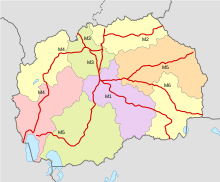
North Macedonia is in its position a continental country in the middle of the Balkan peninsula, and the main transport links in the country are those that connect the different parts of the peninsula (transbalkan links). Particularly important is the connection between north–south and Vardar valley, which connects Greece with the rest of Europe.
The total length of the railway network in North Macedonia is 699 km. The most important railway line is the line on the border with Serbia – Kumanovo – Skopje – Veles – Gevgelija – border with Greece. Since 2001, the railway line Beljakovci has been built – the border with Bulgaria, which will get a direct connection Skopje-Sofia. The most important railway hub in the country is Skopje, while the other two are Veles and Kumanovo.
North Macedonia Post is the state-owned company for the provision of postal traffic. It was founded in 1992 as PTT Macedonia. In 1993 it was admitted to the World Postal Union in 1997, PTT Macedonia was divided into Macedonian Telekom and Macedonian Post (later renamed North Macedonia Post).
As far as water transport is concerned, only lake traffic through Ohrid and Prespan Lake has been developed, mostly for tourist purposes.
There are 17 airports officially in North Macedonia, of which 11 are with solid substrates. Among them are two airports of international character, since they are listed on the airport's IATA Airport code International Airport Skopje and Ohrid "St. Paul the Apostle" Airport.
Tourism
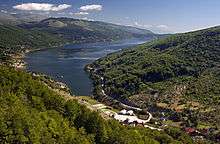
Tourism is an important part of the economy of North Macedonia. The country's abundance of natural and cultural attractions make it an attractive destination of visitors. It receives about 700,000 tourists annually.[219]
Demographics
The last census data from 2002 shows a population of 2,022,547 inhabitants.[2] The last official estimate from 2009, without significant change, gives a figure of 2,050,671.[220] According to the last census data, the largest ethnic group in the country are the ethnic Macedonians. The second largest group are the Albanians, who dominated much of the northwestern part of the country. Following them, Turks are the third biggest ethnic group of the country where official census data put them close to 80,000 and unofficial estimates suggest numbers between 170,000 and 200,000. Some unofficial estimates indicate that there are possibly up to 260,000 Romani.[221]
Religion
Religion in North Macedonia (2002)[222]
Eastern Orthodox Christianity is the majority faith of North Macedonia, making up 65% of the population, the vast majority of whom belong to the Macedonian Orthodox Church. Various other Christian denominations account for 0.4% of the population. Muslims constitute 33.3% of the population. North Macedonia has the fifth-highest proportion of Muslims in Europe, after those of Kosovo (96%),[223] Turkey (90%),[224] Albania (59%),[225] and Bosnia and Herzegovina (51%).[226] Most Muslims are Albanians, Turks, or Romani; few are Macedonian Muslims. The remaining 1.4% was determined to be "unaffiliated" by a 2010 Pew Research estimation.[227]
All together, there were 1,842 churches and 580 mosques in the country at the end of 2011.[228] The Orthodox and Islamic religious communities have secondary religion schools in Skopje. There is an Orthodox theological college in the capital. The Macedonian Orthodox Church has jurisdiction over 10 provinces (seven in the country and three abroad), has 10 bishops and about 350 priests. A total of 30,000 people are baptised in all the provinces every year.
Relations between the Macedonian Orthodox Church, which declared autocephaly in 1967 and remains unrecognised by the other Orthodox Churches, and the Serbian Orthodox Church, which claims ecclesiastical jurisdiction over North Macedonia, remain tense and politically fraught, especially since the Serbian Church appointed Jovan Vraniškovski as its Exarch for the Archbishopric of Ohrid in September 2002.
The reaction of the Macedonian Orthodox Church was to cut off all relations with the new Ohrid Archbishopric and to prevent bishops of the Serbian Orthodox Church from entering North Macedonia. Bishop Jovan was jailed for 18 months for "defaming the Macedonian Orthodox church and harming the religious feelings of local citizens" by distributing Serbian Orthodox church calendars and pamphlets.[229]
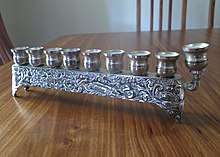
The Macedonian Byzantine Catholic Church has approximately 11,000 adherents in North Macedonia. The Church was established in 1918, and is made up mostly of converts to Catholicism and their descendants. The Church is of the Byzantine Rite and is in communion with the Roman and Eastern Catholic Churches. Its liturgical worship is performed in Macedonian.[230]
There is a small Protestant community. The most famous Protestant in the country is the late president Boris Trajkovski. He was from the Methodist community, which is the largest and oldest Protestant church in the Republic, dating back to the late 19th century. Since the 1980s the Protestant community has grown, partly through new confidence and partly with outside missionary help.
The Macedonian Jewish community, which numbered some 7,200 people on the eve of World War II, was almost entirely destroyed during the war: only 2% survived the Holocaust.[231] After their liberation and the end of the War, most opted to emigrate to Israel. Today, the country's Jewish community numbers approximately 200 persons, almost all of whom live in Skopje. Most Macedonian Jews are Sephardic – the descendants of 15th-century refugees who had been expelled from Castile, Aragon and Portugal.
Languages
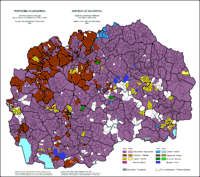
National and official language in all aspects of the whole territory of North Macedonia and in its international relations, is the Macedonian language. Albanian is co-official at a state level (excluding defence, central police and monetary policy) and in local self-government units where speakers are 20% or more. Macedonian belongs to the Eastern branch of the South Slavic language group, while Albanian occupies an independent branch of the Indo-European family of languages. In municipalities where at least 20% of the population is part of another ethnic minority, those individual languages are used for official purposes in local government, alongside Macedonian and Albanian or just Macedonian.
Macedonian is closely related to and mutually intelligible with standard Bulgarian. It also has some similarities with standard Serbian and the intermediate Torlakian/Shop dialects spoken mostly in southeastern Serbia and western Bulgaria (and by speakers in the northeast of Macedonia). The standard language was codified in the period following World War II and has accumulated a thriving literary tradition.
Besides Macedonian and Albanian, minority languages with substantial numbers of speakers are Turkish (including Balkan Gagauz[232]), Romani, Serbian/Bosnian and Aromanian (including Megleno-Romanian).[233][234][235][236][237] Macedonian Sign Language is the primary language of those of the deaf community who did not pick up an oral language in childhood.
According to the last census, 1,344,815 citizens of North Macedonia declared that they spoke Macedonian, 507,989 declared Albanian, 71,757 Turkish, 38,528 Romani, 24,773 Serbian, 8,560 Bosnian, 6,884 Aromanian and 19,241 spoke other languages.[1]
Cities
Education
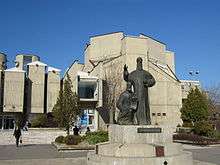
The higher levels of education can be obtained at one of the five state universities: Ss. Cyril and Methodius University of Skopje, St. Clement of Ohrid University of Bitola, Goce Delčev University of Štip, State University of Tetovo and University for Information Science and Technology "St. Paul The Apostle" in Ohrid. There are a number of private university institutions, such as the European University,[238] Slavic University in Sveti Nikole, the South East European University and others.
The United States Agency for International Development has underwritten a project called Macedonia Connects, which has made North Macedonia the first all-broadband wireless country in the world. The Ministry of Education and Sciences reports that 461 schools (primary and secondary) are now connected to the internet.[239] In addition, an Internet service provider (On.net), has created a MESH Network to provide WIFI services in the 11 largest cities/towns in the country. The national library of North Macedonia, National and University Library "St. Kliment of Ohrid", is in Skopje.
The North Macedonian education system consists of:
- pre-school education
- primary
- secondary
- higher
Culture
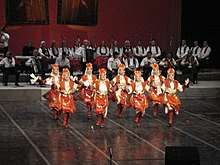
North Macedonia has a rich cultural heritage in art, architecture, poetry, and music. It has many ancient, protected religious sites. Poetry, cinema, and music festivals are held annually. Macedonian music styles developed under the strong influence of Byzantine church music. North Macedonia has a significant number of preserved Byzantine fresco paintings, mainly from the period between the 11th and 16th centuries. There are several thousands square metres of fresco painting preserved, the major part of which is in very good condition and represent masterworks of the Macedonian School of ecclesiastical painting.
The most important cultural events in the country are the Ohrid Summer festival of classical music and drama, the Struga Poetry Evenings which gather poets from more than 50 countries in the world, International Camera Festival in Bitola, Open Youth Theatre and Skopje Jazz Festival in Skopje etc. The National Opera opened in 1947, then named "Macedonian Opera", with a performance of Cavalleria rusticana under the direction of Branko Pomorisac. Every year, the May Opera Evenings are held in Skopje for around 20 nights. The first May Opera performance was that of Kiril Makedonski's Tsar Samuil in May 1972.[240]
Cuisine
_(3).jpg)
The country's cuisine is a representative of that of the Balkans – reflecting Mediterranean and Middle Eastern (Ottoman) influences, and to a lesser extent Italian, German and Eastern European (especially Hungarian) ones.[241] The relatively warm climate in North Macedonia provides excellent growth conditions for a variety of vegetables, herbs and fruits. Thus, Macedonian cuisine is particularly diverse.
Famous for its rich Šopska salad, an appetiser and side dish which accompanies almost every meal, Macedonian cuisine is also noted for the diversity and quality of its dairy products, wines, and local alcoholic beverages, such as rakija. Tavče Gravče and mastika are considered the national dish and drink of North Macedonia, respectively.
Sport


Football and handball are the most popular sports in North Macedonia. The national football team is controlled by the Football Federation of Macedonia. Their home stadium is the Toše Proeski Arena. In November 2003, to celebrate UEFA's jubilee, Darko Pančev was selected as the Golden Player of Macedonia as their most outstanding player of the past 50 years.[242] He was the winner of the European Golden Boot award in 1991 and he is best known for scoring the winning penalty in the 1991 European Cup Final, bringing Red Star Belgrade the most prestigious trophy in European football for the first time in its 50-year existence.
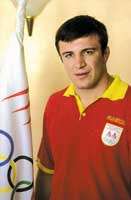
Handball is the other important team sport in the country. In 2002 Kometal Skopje won the EHF Women's Champions League European Cup. The European Women's Handball Championship took place in 2008 in North Macedonia. The venues in which the tournament took place were located in Skopje and Ohrid; the national team finished seventh place. Macedonian clubs enjoyed success in European competitions. RK Vardar won 2016–17 and 2018–19 EHF Champions League, while Kometal Gjorče Petrov Skopje won the women's event in 2002.
The North Macedonia national basketball team represents North Macedonia in international basketball. The team is run by the Basketball Federation of North Macedonia, the governing body of basketball in North Macedonia which was created in 1992 and joined FIBA in 1993. North Macedonia has participated in three Eurobaskets since then with its best finish at 4th place in 2011. It plays its home games at the Boris Trajkovski Arena in Skopje. Pero Antić became the first Macedonian basketball player to play in the National Basketball Association. He also won three EuroLeague trophies.
In the summer months The Ohrid Swimming Marathon is an annual event on Lake Ohrid and during the winter months there is skiing in North Macedonia's winter sports centres. North Macedonia also takes part in the Olympic Games. Participation in the Games is organised by the Olympic Committee of North Macedonia.[243] Magomed Ibragimov competed for FYR Macedonia in the freestyle 85 kg competition at the 2000 Summer Olympics and won the bronze medal, which was the first medal for independent country. Wrestlers Shaban Tërstena and Shaban Sejdiu born in North Macedonia, as well as boxers Redžep Redžepovski and Ace Rusevski, won Olympic medals as part of Yugoslav Olympic team.
Cinema
The history of film making in the country dates back over 110 years. The first film to be produced on the territory of the present-day the country was made in 1895 by Janaki and Milton Manaki in Bitola. Throughout the past century, the medium of film has depicted the history, culture and everyday life of the Macedonian people. Over the years many Macedonian films have been presented at film festivals around the world and several of these films have won prestigious awards. The first Macedonian feature film was Frosina, released in 1952. The first feature film in colour was Miss Stone, a movie about a Protestant missionary in Ottoman Macedonia. It was released in 1958. The highest grossing feature film in North Macedonia was Bal-Can-Can, having been seen by over 500,000 people in its first year alone. In 1994, Milcho Manchevski's film Before the Rain was nominated for an Academy Award in the category of Best International Feature Film.[244] Manchevski continues to be the most prominent modern filmmaker in the country having subsequently written and directed Dust and Shadows. In 2020, the documentary Honeyland (2019) directed by Tamara Kotevska and Ljubomir Stefanov, received nominations in the categories for Best International Feature Film and Best Documentary Feature at the 92nd Academy Awards, making it the first non-fictional film to receive a nomination in both categories.[245]
Media
The oldest newspaper in the country is Nova Makedonija from 1944. Other well known newspaper and magazines are: Utrinski vesnik, Dnevnik, Vest, Fokus, Večer, Tea Moderna, Makedonsko Sonce, and Koha. Public channel is Macedonian Radio-Television founded in 1993 by the Assembly of North Macedonia. TEKO TV (1989) from Štip is the first private television channel in the country. Other popular private channels are: Sitel, Kanal 5, Telma, Alfa TV, and Alsat-M.
Public holidays
The main public holidays in North Macedonia are:
| Date | English name | Macedonian name | Remarks |
|---|---|---|---|
| 1–2 January | New Year | Нова Година, Nova Godina | |
| 7 January | Christmas Day (Orthodox) | Прв ден Божик, Prv den Božik | |
| April/May | Good Friday (Orthodox) | Велики Петок, Veliki Petok | Orthodox Easter and other Easter dates do not match; see: List of dates for Easter |
| April/May | Easter Sunday (Orthodox) | Прв ден Велигден, Prv den Veligden | |
| April/May | Easter Monday (Orthodox) | Втор ден Велигден, Vtor den Veligden | |
| 1 May | Labour Day | Ден на трудот, Den na trudot | |
| 24 May | Saints Cyril and Methodius Day | Св. Кирил и Методиј, Ден на сèсловенските просветители; Sv. Kiril i Metodij, Den na sèslovenskite prosvetiteli | |
| 2 August | Republic Day | Ден на Републиката, Den na Republikata | Day when the Republic was established in 1944, also Ilinden Uprising in 1903. |
| 8 September | Independence Day | Ден на независноста, Den na nezavisnosta | Day of independence from Yugoslavia |
| 11 October | Day of Macedonian Uprising in 1941 | Ден на востанието, Den na vostanieto | Beginning of Anti-fascist war during WWII in 1941 |
| 23 October | Day of the Macedonian Revolutionary Struggle (Holiday) | Ден на македонската револуционерна борба,Den na makedonskata revolucionarna borba | Day when the Internal Macedonian Revolutionary Organization (IMRO) was established in 1893. |
| 1 Shawwal | Eid ul-Fitr | Рамазан Бајрам, Ramazan Bajram | moveable, see: Islamic Calendar |
| 8 December | Saint Clement of Ohrid Day | Св. Климент Охридски, Sv. Kliment Ohridski |
Besides these, there are several major religious & minorities holidays. (See: Public holidays in North Macedonia)
International rankings
| Organisation | Survey | Ranking |
|---|---|---|
| Institute for Economics and Peace | Global Peace Index 2019[246] | 65 out of 163 |
| Reporters Without Borders | Worldwide Press Freedom Index 2019[247] | 95 out of 180 |
| The Heritage Foundation/The Wall Street Journal | Index of Economic Freedom 2019[248] | 33 out of 180 |
| Transparency International | Corruption Perceptions Index 2019[249] | 106 out of 180 |
| United Nations Development Programme | Human Development Index 2019[250] | 82 out of 189 |
| World Bank | Ease of doing business index 2019[251] | 10 out of 190 |
See also
- Outline of North Macedonia
Notes
- National and official language in all aspects of the whole territory of the state and in its international relations.
- Co-official language at a state level (excluding defence, central police and monetary policy) and in local self-government units where speakers are 20% or more.
- Macedonian: Северна Македонија, romanized: Severna Makedonija [ˈsɛvɛrna makɛˈdɔnija]; Albanian: Maqedonia e Veriut [macɛˈdɔnja ɛ vɛɾˈjut]
- Macedonian: Република Северна Македонија, romanized: Republika Severna Makedonija [rɛˈpublika ˈsɛvɛrna makɛˈdɔnija]; Albanian: Republika e Maqedonisë së Veriut [rɛˈpublika ɛ macɛˈdɔnis sə vɛɾˈjut]
- Kosovo is the subject of a territorial dispute between the Republic of Kosovo and the Republic of Serbia. The Republic of Kosovo unilaterally declared independence on 17 February 2008, but Serbia continues to claim it as part of its own sovereign territory. The two governments began to normalise relations in 2013, as part of the 2013 Brussels Agreement. Kosovo is currently recognized as an independent state by 97 out of the 193 United Nations member states. In total, 112 UN member states recognized Kosovo at some point, of which 15 later withdrew their recognition.
- United Nations General Assembly resolution 47/225 of 8 April,[9] United Nations Security Council Resolutions 817 of 7 April and 845 of 18 June 1993[10]
- This policy changed after 1943 with the arrival of Tito's envoy Montenegrin Serb Svetozar Vukmanović-Tempo. He began in earnest to organise armed resistance to the Bulgarian rule and sharply criticised Sharlo's pro-Bulgarian policy. At a meeting of the partisan brigades, as well as a group of battalions in the Resen region on 21 December 1943, Tempo makes the following comments about Shatorov and the leadership of the MCP: "They thought that the Macedonian people were Bulgarians and that they were oppressed by the hegemony of Great Serbia and had to be transferred to Bulgaria. Their basic slogan is: 'All non-Macedonians out of Macedonia'. The capital J [Serbo-Croatian spelling of Yugoslavia, Yugoslavian, etc.] was deleted from all documents. In fact they did not want Yugoslavia, no matter where it stood politically. When the war started, the initial decision of this leadership was to be separate from Yugoslavia and from Tito. They declared that Macedonia would be free as soon as the Bulgarians came...."
- The breed was initially standardised by the Yugoslavian Federation of Cynology (Jugoslovenski kinološki savez, JKS) and recognised as a Yugoslav breed with two types by the Fédération Cynologique Internationale (FCI) in 1939 under the designation Ilirski ovčar (Illyrian Shepherd Dog), FCI-Standard N° 41. Kraški ovčar and Šarplaninac were considered Type A and B of the breed. In 1957, the General Assembly of the F.C.I. accepted a motion proposed by the Yugoslavian Federation of Cynology to change the name of the breed to Jugoslovenski ovčarski pas Šarplaninac (Yugoslavian Shepherd Dog Sharplanina), and this is the official name of the breed. After the collapse of Yugoslavia, Macedonia and Serbia were recognised as the countries of origin. In 1968, type B was recognised as a separate breed under the designation Kraški ovčar (Karst Shepherd Dog), FCI-Standard N° 278.
References
- "Census final data" (PDF). stat.gov.mk. 2002.
- "Census of Population, Households and Dwellings in the Republic of Macedonia, 2002 – Book XIII, Skopje, 2005" (PDF). State Statistical Office of the Republic of Macedonia. Retrieved 10 February 2016.
- "Population on 1 January". ec.europa.eu/eurostat. Eurostat. Retrieved 14 January 2020.
- "Report for Selected Countries and Subjects". IMF. 20 October 2018.
- "Gini coefficient of equivalised disposable income - EU-SILC survey". ec.europa.eu/eurostat. Eurostat. Retrieved 13 January 2020.
- "Human Development Index (HDI)". hdr.undp.org. HDRO (Human Development Report Office) United Nations Development Programme. Retrieved 11 December 2019.
- "Basic Facts". Republic of Macedonia, Ministry of Foreign Affairs. Archived from the original on 16 November 2008.
- "Paeonia – historical region".
- A/RES/47/225, resolution for the UN GA 98th plenary meeting, 8 April 1993
- UN SC resolutions made in 1993
- "The World Bank in North Macedonia". World Bank. Retrieved 11 August 2019.
- Μακεδονία, Henry George Liddell, Robert Scott, A Greek–English Lexicon, on Perseus
- Macedonia, Online Etymology Dictionary
- μακεδνός, Henry George Liddell, Robert Scott, A Greek-English Lexicon, on Perseus
- μακρός, Henry George Liddell, Robert Scott, A Greek–English Lexicon, on Perseus
- Eugene N. Borza, Makedonika, Regina Books, ISBN 0-941690-65-2, p. 114: The "highlanders" or "Makedones" of the mountainous regions of western Macedonia are derived from northwest Greek stock; they were akin both to those who at an earlier time may have migrated south to become the historical "Dorians".
- Nigel Guy Wilson (2009). Encyclopedia of Ancient Greece, Routledge, p. 439: The latest archaeological findings have confirmed that Macedonia took its name from a tribe of tall, Greek-speaking people, the Makednoi.
- Beekes, Robert (2010), Etymological Dictionary of Greek, II, Leiden, Boston: Brill, p. 894
- De Decker, Filip (2016). "AN ETYMOLOGICAL CASE STUDY ON THE AND VOCABULARY IN ROBERT BEEKES'S NEW ETYMOLOGICAL DICTIONARY OF GREEK". Studia Linguistica Universitatis Iagellonicae Cracoviensis. 133 (2). doi:10.4467/20834624SL.16.006.5152.
- "What is often overlooked is how Bulgarians and Greeks collaborated unknowingly from the middle decades of the 19th century onward in breathing new life into the geographical name Macedonia, which was all but forgotten during the Byzantine and Ottoman periods. In the late Ottoman period, ‘‘Macedonia’’ as such did not exist as an administrative unit in the empire... Greek nationalism, fixated on the continuity between ancient and modern Hellenes, was keen to project the name Macedonia as a way to assert the Greek historical character of the area. In 1845, for instance, the story of Alexander was published in a Slavo-Macedonian dialect scripted in Greek characters... For their part, Bulgarian nationalists readily accepted Macedonia as a regional denomination... Macedonia had become one of the ‘‘historic’’ Bulgarian lands... and ‘‘Macedonian Bulgarian’’ turned into a standard phrase." Dimitar Bechev, Historical Dictionary of the Republic of Macedonia, Scarecrow Press, 2009, ISBN 0810862956, Introduction, p. VII.
- "In the early 19th c. the modern Greeks with their Western-derived obsession with antiquity played a crucial role in reviving the classical name ‘Macedonia’ in the popular consciousness of the Balkan peoples. For a thousand years before that the name ‘Macedonia’ had meant different things for Westerners and Balkan Christians: for Westerners it always denoted the territories of the ancient Macedonians, but for the Greeks and all other Balkan Christians the name ‘Macedonia’ – if at all used – covered the territories of the former Byzantine theme ‘Macedonia’, situated between Adrianople (Edrine) and the river Nestos (Mesta) in classical and present-day Thrace. The central and northern parts of present-day ‘geographic Macedonia’ were traditionally called either ‘Bulgaria’ and ‘Lower Moesia’, but within a generation after Greek independence (gained in 1830) these names were replaced by ‘Macedonia’ in the minds of both Greeks and non-Greeks." Drezov K. (1999) Macedonian identity: an overview of the major claims. In: Pettifer J. (eds) The New Macedonian Question. St Antony’s Series. Palgrave Macmillan, London, ISBN 0230535798, pp. 50-51.
- "In 1813 Macedonia did not exist. A century later, it had become a hotly contested nationalist cause, a battlefield, and an obsession. What led to this dramatic transformation was modernity: a chilly wind of West European provenance that propelled to the Balkans concepts that few in the region understood, wanted or cared about. Among these, the idea of nationalism was the most potent, and the most lethal. Before the 1850s, Macedonia was a poverty-stricken province of the Ottoman Empire, where an Orthodox Christian and mostly peasant population speaking a variety of Slavonic idioms, Greek, or Vlach, was trying to eke out a modest living, and protect it from rapacious brigands and a decaying Ottoman administrative system. Religion was the only collective identity that most of them could make sense of, for ethnicity and language played little role in shaping their loyalties. But the winds of change quickly gathered momentum, and eventually shattered that multi-ethnic community, producing a 'Greek', or a 'Bulgarian', out of a 'Christian'." D. Livanios' review of Vemund Aarbakke, Ethnic Rivalry and the Quest for Macedonia, 1870-1913 in The Slavonic and East European Review, Vol. 83, No. 1 (Jan., 2005), pp. 141-142
- The ancient name 'Macedonia' disappeared during the period of Ottoman rule and was only restored in the nineteenth century originally as geographical term. The Oxford Handbook of the History of Nationalism, John Breuilly, Oxford University Press, 2013, ISBN 0199209197, p. 192.
- The region was not called "Macedonia" by the Ottomans, and the name "Macedonia" gained currency together with the ascendance of rival nationalism. Collective Memory, National Identity, and Ethnic Conflict: Greece, Bulgaria, and the Macedonian Question, Victor Roudometof, Greenwood Publishing Group, 2002, ISBN 0275976483, p. 89.
- The Greeks were amongst the first to define these lands since the beginning of the 19th century. For educated Greeks, Macedonia was the historical Greek land of kings Philip and Alexander the Great. John S. Koliopoulos, Thanos M. Veremis, Modern Greece: A History since 1821. A New History of Modern Europe, John Wiley & Sons, 2009, ISBN 1444314831, p. 48.
- Donald Bloxham, The Final Solution: A Genocide, OUP Oxford, 2009, ISBN 0199550336, p. 65.
- Chris Kostov, Contested Ethnic Identity: The Case of Macedonian Immigrants in Toronto, Peter Lang, 2010, ISBN 3034301960, p. 76.
- "Greece and Macedonia sign agreement on name change". Al Jazeera.
- Niki Kitsantonis (17 June 2018). "Macedonia and Greece Sign Historic Deal on Name Change". The New York Times.
- Testorides, Konstantin; Becatoros, Elena (30 September 2018). "Macedonia: Referendum approves name change, but turnout low".
- "PM to press on with Macedonia name change". BBC. 1 October 2018.
- Agencies (20 October 2018). "Welcome to North Macedonia: parliament votes for name change". the Guardian.
- Casule, Kole (11 January 2019). "Macedonia parliament agrees to change country's name". Reuters. Retrieved 17 August 2019.
- "Greece vote settles 27-year Macedonia row". BBC. 25 January 2019. Retrieved 25 January 2019.
- Ovid (2005). Green, Peter (ed.). The Poems of Exile: Tristia and the Black Sea Letters. University of California Press. p. 319. ISBN 978-0520242609.
Ovid was lax in his geography, not least over Paeonia (in fact roughly coextensive with the present Slav republic of Macedonia).
- Roisman, Joseph; Worthington, Ian (2010). A Companion to Ancient Macedonia. John Wiley and Sons. p. 13. ISBN 978-1-4051-7936-2. Retrieved 10 February 2016.CS1 maint: ref=harv (link)
- Reames, Jeanne; Howe, Timothy (2008). Macedonian Legacies: Studies in Ancient Macedonian History and Culture in Honor of Eugene N. Borza. Regina Books. p. 239. ISBN 978-1930053564.
Having just conquered Paeonia (roughly where the Former Yugoslav Republic of Macedonia is today).
- Peshkopia, Ridvan (2015). Conditioning Democratization: Institutional Reforms and EU Membership Conditionality in Albania and Macedonia. Anthem Press. p. 189. ISBN 978-0857283252.
Indeed, the territory of the Republic of Macedonia encompasses little of the ancient kingdom of Macedon, which, in most part, overlaps with the current region of the contemporary Greece, but the name Macedonia "flowed" northward with the creation of Roman region of Macedonia, after the Romans occupied Greece in 168 BC. Besides the former kingdom of Macedon, the Roman region included the territories of Paeonia, where the contemporary FYR Macedonia rests.
- Strabo, Geography, Book 7, Frg. 4:
- Bauer, Susan Wise (2007). The History of the Ancient World: From the Earliest Accounts to the Fall of Rome, ISBN 0-393-05974-X, p. 518: "...to the north, Thracian tribes known collectively as the Paeonians."
- Willkes, John (1996). The Illyrians. Wiley-Blackwell. p. 49. ISBN 978-0-631-19807-9. Retrieved 10 February 2016.
- Sealey, Raphael (1976). A history of the Greek city states, ca. 700–338 B.C.. University of California Press. p. 442. ISBN 978-0-520-03177-7.
illyrian lychnitis.
- Evans, Thammy (2007). Macedonia. Bradt Travel Guides. p. 13. ISBN 978-1-84162-186-9.
- Borza, Eugene N. (1992). In the shadow of Olympus: the emergence of Macedon. Princeton University Press. pp. 74–75. ISBN 978-0-691-00880-6.
- Lewis, D.M.; et al., eds. (1994). The Cambridge ancient history: The fourth century B.C. Cambridge University Press. pp. 723–724. ISBN 978-0-521-23348-4. Retrieved 10 February 2016.
- The Cambridge Ancient History Volume 3, Part 3: The Expansion of the Greek World, Eighth to Sixth Centuries BC by John Boardman and N. G. L. Hammond, 1982, ISBN 0-521-23447-6, p. 284.
- Howe & Reames 2008, p. 239.
- Roisman & Worthington 2011, pp. 135–138, 342–345.
- "Persian influence on Greece (2)". Retrieved 17 December 2014.
- Warfare in the ancient world: from the Bronze Age to the fall of Rome. By Stefan G. Chrissanthos, p. 75
- Poulton, Hugh (2000). Who are the Macedonians?. C. Hurst & Co. Publishers. p. 14. ISBN 978-1-85065-534-3.
- Macedonia yesterday and today Author Giorgio Nurigiani, Publisher Teleurope, 1967 p. 77.
- A Companion to Ancient Macedonia, By Joseph Roisman and Ian Worthington, p. 549
- "Encyclopædia Britannica – Scopje". Britannica.com. Retrieved 6 June 2011.
- A. F. Christidis (2007). A History of Ancient Greek: From the Beginnings to Late Antiquity, Cambridge University Press, p. 351: "Despite Roman domination, there was no retreat on the part of Greek tradition in the eastern part of the empire, and only in Macedonia did Latin spread in some extent".
- "Acta Sancti Demetrii", V 195–207, Гръцки извори за българската история, 3, стр. 159–166
- S. Runciman. "A history of the First Bulgarian empire – Appendix 9". www.promacedonia.org.
- Nicol, Donald Macgillivray (1993). The last Centuries of Byzantium, (1261–1453). Cambridge University Press. p. 500. ISBN 978-0-521-43991-6. Retrieved 10 February 2016.
- Encyclopædia Britannica – Rumelia at Encyclopædia Britannica.com
- The Encyclopædia Britannica, or, Dictionary of arts, sciences ..., Volume 19. 1859. p. 464.
- Phillips, John (2004). Macedonia: Warlords and Rebels in the Balkans. I.B. Tauris. p. 41. ISBN 978-1-86064-841-0.
- Sampimon, Janette (2006). Becoming Bulgarian: The articulation of Bulgarian identity in the nineteenth century in its international context: An intellectual history. p. 234. ISBN 978-90-6143-311-8.
- Clarke, James Franklin; Hupchick, Dennis P. (1988). The pen and the sword: Studies in Bulgarian history. p. 221. ISBN 978-0-88033-149-4.
Peichinovich of Tetovo, Macedonia, author of one of the first Bulgarian books
- Gawrych, George (2006). The Crescent and the Eagle: Ottoman Rule, Islam and the Albanians, 1874–1913. p. 28. ISBN 978-1-84511-287-5.
- Bechev, Dimitar (2009). Historical Dictionary of the Republic of Macedonia. p. 100. ISBN 978-0-8108-5565-6. Retrieved 14 November 2011.
- Roth, Klaus; Brunnbauer, Ulf (2008). Region, Regional Identity and Regionalism in Southeastern Europe. LIT Verlag Münster. ISBN 9783825813871 – via Google Books.
- Stanford J. Shaw (1977). History of the Ottoman Empire and Modern Turkey: Volume 2, Reform, Revolution, and Republic: The Rise of Modern Turkey 1808–1975. Cambridge University Press. p. 209. ISBN 978-0-521-29166-8.
- There was even an attempt to form a kind of revolutionary government led by the socialist Nikola Karev. The Krushevo manifesto was declared, assuring the population that the uprising was against the Sultan and not against Muslims in general, and that all peoples would be included. As the population of Krushevo was two-thirds hellenised Vlachs and Patriarchist Slavs, this was a wise move. Despite these promises, the insurgent flew Bulgarian flags everywhere and in many places the uprising did entail attacks on Muslim Turks and Albanians who themselves organised for self-defence." Who are the Macedonians? Hugh Poulton, C. Hurst & Co. Publishers, 1995, ISBN 1850652384, p. 57.
- In fact Macedonian historians as Blaze Ristovski have recognized, that the "government" of the "republic", nowadays a symbol of Macedonian statehood, was actually composed of people who identified themselves as "Greeks", "Vlachs" and "Bulgarians". "We, the People: Politics of National Peculiarity in Southeastern Europe" Diana Mishkova, Central European University Press, 2009, ISBN 9639776289, p. 124.
- "The IMARO activists saw the future autonomous Macedonia as a multinational polity, and did not pursue the self-determination of Macedonian Slavs as a separate ethnicity. Therefore, Macedonian was an umbrella term covering Bulgarians, Turks, Greeks, Vlachs, Albanians, Serbs, Jews, and so on." Historical Dictionary of Macedonia, Historical Dictionaries of Europe, Dimitar Bechev, Scarecrow Press, 2009, ISBN 0810862956, Introduction.
- The political and military leaders of the Slavs of Macedonia at the turn of the century seem not to have heard the call for a separate Macedonian national identity; they continued to identify themselves in a national sense as Bulgarians rather than Macedonians.[...] (They) never seem to have doubted "the predominantly Bulgarian character of the population of Macedonia". "The Macedonian conflict: ethnic nationalism in a transnational world", Princeton University Press, Danforth, Loring M. 1997, ISBN 0691043566, p. 64.
- Nicolle 2008, p. 162
- Banac, Ivo (1984). The National Question in Yugoslavia. Origins, History, Politics. London and Ithaka: Cornell University Press. p. 317. ISBN 978-0801416750.
- Paul Mojzes, Balkan Genocides: Holocaust and Ethnic Cleansing in the Twentieth Century, Rowman & Littlefield, 2011, ISBN 1442206632, p. 38.
- Йосиф Разсуканов, 85 години от Охриско-Дебърското въстание, в-к "Македония", брой 33, 16 септември 1998 г.
- "Kraljevina Jugoslavija! Novi naziv naše države. No, mi smo itak med seboj vedno dejali Jugoslavija, četudi je bilo na vseh uradnih listih Kraljevina Srbov, Hrvatov in Slovencev. In tudi drugi narodi, kakor Nemci in Francozi, so pisali že prej v svojih listih mnogo o Jugoslaviji. 3. oktobra, ko je kralj Aleksander podpisal "Zakon o nazivu in razdelitvi kraljevine na upravna območja", pa je bil naslov kraljevine Srbov, Hrvatov in Slovencev za vedno izbrisan." (Naš rod ("Our Generation", a monthly Slovenian language periodical), Ljubljana 1929/30, št. 1, str. 22, letnik I.)
- Dejan Djokić, Yugoslavism: histories of a failed idea, 1918–1992, p. 123, at Google Books
- Eastern Europe in the twentieth century – and after, p. 20, at Google Books
- "An article by Dimiter Vlahov about the persecution of the Bulgarian population in Macedonia". newspaper "Balkanska federatsia", No. 140, 20 August 1930, Vienna, original in Bulgarian. Retrieved 3 August 2007.
- Chris Kostov, Contested Ethnic Identity: The Case of Macedonian Immigrants in Toronto, 1900-1996, Peter Lang, 2010, ISBN 3034301960, p. 77.
- Cathie Carmichael, Ethnic Cleansing in the Balkans: Nationalism and the Destruction of Tradition, Routledge, 2003, ISBN 1134479530, p. 138.
- Mercia MacDermott, For freedom and perfection. The Life of Yané Sandansky, Journeyman, London, 1988, p. 451.
- War of words: Washington tackles the Yugoslav conflict, p. 43, at Google Books
- Fischer, Bernd Jürgen (2007). Balkan Strongmen: Dictators and Authoritarian Rulers of South Eastern Europe. Purdue University Press. ISBN 978-1557534552 – via Google Books.
- Gerginov, Kr., Bilyarski, Ts. Unpublished documents for Todor Alexandrov's activities 1910–1919, magazine VIS, book 2, 1987, p. 214 – Гергинов, Кр. Билярски, Ц. Непубликувани документи за дейността на Тодор Александров 1910–1919, сп. ВИС, кн. 2 от 1987, с. 214.
- Victor Roudometof, Collective Memory, National Identity, and Ethnic Conflict: Greece, Bulgaria, and the Macedonian Question, Praeger, 2002 p. 100
- Vassil Karloukovski. "Гиза, Антони, "Балканските държави и Македония", Македонски Научен Институт София, 2001 г". Promacedonia.org. Retrieved 28 April 2010.
- Bechev, Dimitar (2009). Historical Dictionary of the Republic of Macedonia. Scarecrow Press. ISBN 978-0810862951 – via Google Books.
- Duncan Perry, "The Republic of Macedonia: finding its way" in Karen Dawisha and Bruce Parrot (eds.), Politics, power and the struggle for Democracy in South-Eastern Europe, Cambridge University Press, 1997, pp. 228–229.
- Bulgarian Campaign Committees in Macedonia – 1941 Dimitre Mičev
- "Forming of the Local Campaign Committees". kroraina.com.
- Historical dictionary of the Republic of Macedonia, Valentina Georgieva, Sasha Konechni, Scarecrow Press, 1998, ISBN 0-8108-3336-0, p. 223.
- Hugh Poulton (1995). Who are the Macedonians?. C. Hurst & Co. Publishers. p. 102. ISBN 978-1-85065-238-0. Retrieved 10 February 2016.
- Miller, Marshall Lee (1975). Bulgaria during the Second World War. Stanford University Press. p. 314. ISBN 978-0-8047-0870-8. Retrieved 10 February 2016.
- Bulgaria managed to save its entire 48,000-strong Jewish population during World War II from deportation to Nazi concentration camps, but under German pressure those Jews from their newly annexed territories without Bulgarian citizenship were deported, such as those from Vardar Macedonia and Western Thrace. The Holocaust in Macedonia: Deportation of Monastir Jewry United States Holocaust Memorial Museum
- Mark Cohen, The Holocaust in Macedonia: Deportation of Monastir Jewry, United States Holocaust Memorial Museum
- "НОБ на Македонија" Јован Поповски. Скопје, 1962
- "Историја на Македонскиот Народ" Александар Стојановски, Иван Катарџиев, Данчо Зографски. Скопје, 1988
- History of Bulgaria, Petar Delev et al., 2001, p. 364
- Axis Forces in Yugoslavia 1941–45. Bloomsbury. 1995. ISBN 978-1855324732 – via Google Books.
- Мичев, Добрин. Партизанското движение във Вардарска Македония, 1941–1944 г. сп. Македонски преглед, кн. 2, стр. 5–40.
- "Constitution of the Socialist Republic of Macedonia, 1974 – Official Gazette of the Republic of Macedonia" (PDF).
- Устав Федеративне Народне Републике Југославије (1946), sr.wikisource.org, retrieved on 19 October 2007. (in Serbo-Croatian)
- Устав Социјалистичке Федеративне Републике Југославије (1963), sr.wikisource.org, retrieved on 19 October 2007. (in Serbo-Croatian)
- Nohlen, D & Stöver, P (2010) Elections in Europe: A data handbook, p. 1278 ISBN 978-3-8329-5609-7
- "Recognition of States: Annex 3". Archived from the original on 15 February 2005. Retrieved 28 April 2010.
- Thomas, Nigel (2006). The Yugoslav Wars (2): Bosnia, Kosovo And Macedonia 1992–2001. Osprey Publishing. ISBN 978-1841769646.
- "Who are the rebels?". BBC News. 20 March 2001.
- "Census of Population, Households and Dwellings in the Republic of Macedonia, 2002 – Book XIII, Skopje, 2005" (PDF). State Statistical Office of the Republic of Macedonia.
- Huggler, Justin (12 March 2001). "KLA veterans linked to latest bout of violence in Macedonia". The Independent. London. Retrieved 4 April 2010.
- Brunnbauer, Ulf (2002). "The implementation of the Ohrid Agreement: Ethnic Macedonian resentments" (PDF). Journal on Ethnopolitics and Minority Issues in Europe (1/2002). Archived from the original (PDF) on 23 September 2015. Retrieved 18 May 2015.
- "Clashes between Macedonians and Albanians in Macedonia". rtvfan.net. 5 May 2016.
- "In Macedonia, Ethnic Albanians Protest Arrests Of Murder Suspects". RadioFreeEurope/RadioLiberty. 11 May 2012.
- "Ghosts of the past endanger Macedonia's future". Boris Georgievski, Balkan Insight, 27 October 2009 .
- Greece slates Skopje's provocative Alexander statue Sinisa Jakov Marusic, Balkan Insight, 15 June 2011
- Marusic, Sinisa Jakov (15 June 2018). "Macedonia to Rename Divisive Statues That Irked Greece". BalkanInsight. Skopje. Retrieved 2 April 2019.
- Tagaris, Karolina (24 January 2018). "Macedonia to rename airport to help resolve name row with Greece, PM says". Reuters. Davos. Retrieved 2 April 2019.
- "FINAL AGREEMENT FOR THE SETTLEMENT OF THE DIFFERENCES AS DESCRIBED IN THE UNITED NATIONS SECURITY COUNCIL RESOLUTIONS 817 (1993) AND 845 (1993), THE TERMINATION OF THE INTERIM ACCORD OF 1995, AND THE ESTABLISHMENT OF A STRATEGIC PARTNERSHIP BETWEEN THE PARTIES" (PDF). Kathimerini.gr. Retrieved 13 June 2018. Cite journal requires
|journal=(help) - "Macedonia, Greece sign historic name-change deal". eNCA. 17 June 2018. Retrieved 17 June 2018.
- "Greece, Macedonia sign pact to change ex-Yugoslav republic's name". Reuters. 17 June 2018. Retrieved 17 June 2018.
- "Greece, Macedonia sign historic deal to end name row". Economic Times. 17 June 2018. Archived from the original on 17 June 2018. Retrieved 17 June 2018.
- Marusic, Sinisa Jakov (17 June 2018). "Macedonia, Greece Sign 'Historic' Name Deal". Balkan Insight. Retrieved 17 June 2018.
- "High Representative/Vice-President Federica Mogherini and Commissioner Johannes Hahn to attend the signing ceremony of the agreement on the name issue at Prespa lake". Europa.eu. 17 June 2018. Retrieved 17 June 2018.
- "Prespa: Alexis Tsipras is the first Greek prime minister to visit Macedonia (original: Πρέσπες: Ο Αλέξης Τσίπρας είναι ο πρώτος Έλληνας πρωθυπουργός που επισκέφθηκε την πΓΔΜ)". HuffPost. 17 June 2018. Retrieved 17 June 2018.
- "Tsipras: a patriotic and mutually beneficial agreement for the two countries". ERT. 17 June 2018. Archived from the original on 17 June 2018. Retrieved 17 June 2018.
- Marusic, Sinisa Jakov (27 June 2018). "Macedonia, Albania Hail EU Approval for Accession Talks". Balkan Insight. Retrieved 27 June 2018.
- "Macedonia's parliament endorses name deal with Greece for second time". Reuters. 5 July 2018. Retrieved 6 July 2018.
- Marusic, Sinisa Jakov (11 July 2018). "NATO Invites Macedonia to Join the Western Alliance". Balkan Insight. Retrieved 13 July 2018.
- "Macedonia to hold name-change referendum on September 30". SBS News. 30 July 2018. Retrieved 31 July 2018.
- "iVote Demokra – Integrated Election Information System of the State Election Commission of the Republic of Macedonia". referendum.sec.mk. Archived from the original on 30 September 2018. Retrieved 14 October 2018.
- "Macedonia name referendum fails to reach turnout threshold: election commission". Reuters. 30 September 2018. Retrieved 20 November 2019.
- Sekularac, Ivana; Casule, Kole (29 September 2018). "Macedonia leader vows to press on with name change despite referendum failure". Reuters. Retrieved 1 October 2018.
- Stanev, Yoan (16 October 2018). "'North' Macedonia parliamentary debates hit deadlock". Emerging Europe. Retrieved 17 October 2018.
- "Macedonia parliament to vote on name change". Al Jazeera. 15 October 2018. Retrieved 18 October 2018.
- "πΓΔΜ:Το VMRO αποχώρησε από την συζήτηση για την Συνταγματική Αναθεώρηση". News 24/7 (in Greek). 17 October 2018. Retrieved 18 October 2018.
- "Welcome to North Macedonia: parliament votes for name change". The Guardian. 20 October 2018. Retrieved 20 October 2018.
- "El parlamento aprueba el cambio de nombre de Macedonia a Macedonia del Norte" (video). euronews (in Spanish).
- Smith, Helena (25 January 2019). "Greek MPs ratify Macedonia name change in historic vote". The Guardian. ISSN 0261-3077. Retrieved 25 January 2019.
- "Macedonia signs Nato accession deal". BBC News. 6 February 2019.
- "North Macedonia minister: NATO, not EU, saved name change deal". Euractiv. 19 March 2019.
- "UN Notified Of North Macedonia's Name Change". RFE/RL.
- "Foreign Secretary statement on the Republic of North Macedonia". GOV.UK.
- "Siko-Preis für Tsipras und Zaev wegen Mazedonien-Einigung". BR (in German). 17 February 2019. Retrieved 20 November 2019.
- "Members of European Parliament nominate Tsipras and Zaev for Nobel Peace Prize". European Western Balkans.
- NATO: North Macedonia becomes 30th member, Deutsche Welle (March 27, 2020)
- North Macedonia joins NATO as 30th Ally, NATO (March 27, 2020).
- EU Leaders Give Final OK To Begin North Macedonia, Albania Membership Talks, Radio Free Europe/Radio Liberty (March 27, 2020).
- EU can start talks with Albania and North Macedonia over joining, Reuters (March 23, 2020).
- "Macedonian Ministry of Environment". Archived from the original on 19 January 2008. Retrieved 28 April 2010.
- Encyclopædia Britannica. "Britannica's article about Sar Mountains". Britannica.com. Retrieved 28 April 2010.
- "Sar Mountains on the Euratlas map of the Europe's most significant mountain ranges". Euratlas.com. Retrieved 28 April 2010.
- "Macedonia". Mymacedonia.net. Archived from the original on 23 October 2010. Retrieved 25 January 2010.
- (Georgieva & Konechni 1998, p. 73)
- (Georgieva & Konechni 1998, p. 31).
- Zikov, Mihailo (1995). Клима и климатска регионализација во Република Македонија, "Географски разгледи". Skopje.
- (Georgieva & Konechni 1998, p. 2)
- "Macedonian Flora". Macedonia.co.uk. Retrieved 25 January 2010.
- Schmidt, J. (1912) Danish researches in the Atlantic and Mediterranean on the life-history of the Fresh-water Eel (Anguilla vulgaris, Turt.). Internationale Revue der gesamten Hydrobiologie und Hydrographie 5: 317–342.
- "Macedonian Fauna". macedonia.co.uk.
- Fédération Cynologique Internationale: Official FCI-Standard N° 41, Published 24 November 1970. – Retrieved on 14 February 2015.
- United Kennel Club: Official U.K.C. Breed Standard Archived 2 March 2016 at the Wayback Machine, Revised 1 July 2009. – Retrieved on 30 March 2010.
- "Ahmeti accepts the invitation for dialog with Gruevski". Limun.hr. Retrieved 5 May 2009.
- "VMRO-DPMNE and DUI form ruling coalition in Macedonia". SeTimes. Retrieved 28 April 2010.
- "Macedonia elections pass off peacefully". Irish Times. 3 March 2009. Retrieved 28 April 2010.
- "Tension in Skopje, Talat Xhaferi is elected Assembly Speaker in a situation of chaos". www.balkaneu.com. Retrieved 31 August 2017.
- "Constitution of the Republic of Macedonia" (PDF). Archived from the original (PDF) on 10 January 2017. Retrieved 17 April 2017.
- "Renamed Balkan country seeks closer ties with Nato, EU, PM says". FT.
- "Republic of Macedonia, Ministry of foreign affairs". Mfa.gov.mk. Archived from the original on 16 November 2008. Retrieved 5 May 2009.
- "Republic of Macedonia, Ministry of foreign affairs". Mfa.gov.mk. Archived from the original on 16 November 2008. Retrieved 5 May 2009.
- "Bulgaria: Macedonia Remains Out of NATO Because of Greek Veto over Name Dispute – Novinite.com – Sofia News Agency". Novinite.com. 3 April 2008. Retrieved 5 May 2009.
- "Greece stands by NATO veto threat for Macedonia". Thestar.com.my. Archived from the original on 10 April 2008. Retrieved 5 May 2009.
- "EP Urges Accession Talks For Macedonia". BalkanInsight.com. Retrieved 5 May 2009.
- "Bulgaria vetoes Macedonia's EU accession talks". euractiv.com.
- "Amnesty International – Summary – Macedonia". Web.amnesty.org. Archived from the original on 18 May 2011. Retrieved 6 June 2011.
- "Human Rights Watch – Defending Human Rights Worldwide". 14 April 2013. Archived from the original on 14 April 2013.
- "National Command Management". Archived from the original on 4 September 2010.
- Floudas, Demetrius Andreas; "A Name for a Conflict or a Conflict for a Name? An Analysis of Greece's Dispute with FYROM". 24 (1996) Journal of Political and Military Sociology, 285. 1996. Archived from the original on 27 January 2006. Retrieved 11 February 2008.
- FYROM Name Issue, Hellenic Republic – Ministry of Foreign Affairs
- "It's Time for Macedonia to Accept Compromise". ForeignPolicy. 25 September 2018. Retrieved 13 February 2019.
- "United Nations Resolution 225 (1993)". United Nations. 8 April 1993. Retrieved 28 April 2010.
- Thonemann, Peter; Price, Simon (29 April 2010). The Birth of Classical Europe: A History from Troy to Augustine. Penguin Books. pp. 123–124.
- European Commission. "Background information – The former Yugoslav Republic of Macedonia". Archived from the original on 23 December 2007. Retrieved 1 October 2006.
- European Broadcasting Union. "Members' Logos". Archived from the original on 28 September 2006. Retrieved 1 October 2006.
- "Analytical Report for the Opinion on the application from the former Yugoslav Republic of Macedonia for EU membership" (PDF). Retrieved 28 April 2010.
- "Europa – The EU at a glance – Maps – FYROM". Europa (web portal). Archived from the original on 20 February 2009. Retrieved 5 May 2009.
- International Olympic Committee. "List of national olympic committees participating in the xix olympic winter games in salt lake city" (PDF). Retrieved 1 October 2006.
- "US snubs Greece over Macedonia". BBC News. 4 November 2004. Retrieved 1 October 2006.
- "Naming the solution", Kathimerini English edition, 16 September 2005
- "European Journal of International Law". Archived from the original on 15 February 2005. Retrieved 28 April 2010.
- Floudas, Demetrius Andreas (2002). "Pardon? A Name for a Conflict? FYROM's Dispute with Greece Revisited" (PDF). In George A. Kourvetaris; Andrew Kourvetaris; Kleomenis S. Koutsoukis; Victor Roudometof (eds.). The New Balkans. East European Monographs. Columbia University Press. p. 85. ISBN 978-0-880-33498-3. Archived from the original (PDF) on 25 March 2009. Retrieved 24 July 2009.
- Davorin – Ljubljana. "Macedonia sues Greece for blocking NATO entry". France 24. Retrieved 5 May 2009.
- "The former Yugoslav Republic of Macedonia institutes proceedings against Greece for a violation of Article 11 of the Interim Accord of 13 September 1995" (PDF). International Court of Justice. Archived from the original (PDF) on 16 December 2011. Retrieved 7 December 2011.
- "Application of the Interim Accord of 13 September 1995" (PDF). International Court of Justice. Archived from the original (PDF) on 1 September 2013. Retrieved 13 August 2013.
- Papadimas, Lefteris; Georgiopoulos, George (8 February 2019). "Greek parliament approves protocol for Macedonia to join NATO". Euronews. Athens. Retrieved 2 April 2019.
- "Minister of Foreign Affairs Giorgos Katrougalos' statement following the conclusion of the Friends of North Macedonia working breakfast hosted by Greece and the Romanian Presidency of the Council of the EU (Brussels, 18.03.2019)". Ministry of Foreign Affairs (Greece). Retrieved 2 April 2019.
We wished to send the message that when a country tries to align itself with the European acquis, we Europeans must also respond in the same way and open up the European path to this country.
- Kitsantoni, Niki (17 June 2018). "Macedonia and Greece Sign Historic Deal on Name Change". The New York Times. Athens. Retrieved 2 April 2019.
- "Macedonia to hold name-change referendum on September 30". SBS News. 30 July 2018. Retrieved 31 July 2018.
- "iVote DEMOKRA – Integrated Election Information System of the State Election Commission of the Republic of Macedonia". referendum.sec.mk. Archived from the original on 30 September 2018. Retrieved 14 October 2018.
- "The Latest: Macedonia backs name change to North Macedonia". Associated Press. 11 January 2019. Retrieved 11 January 2019.
- "The constitutional revisions passed by the Macedonian parliament (original: Υπερψηφίστηκε η συνταγματική αναθέωρηση από τη Βουλή της ΠΓΔΜ". Kathimerini. 11 January 2019. Retrieved 11 January 2019.
- "Υπερψηφίστηκε με 153 "ναι" η συμφωνία των Πρεσπών". www.kathimerini.gr. Kathimerini. Retrieved 25 January 2019.
- "Secretary-General Congratulates Greece, Republic of North Macedonia on Settling Long-Standing 'Name' Dispute, as Agreement Enters into Force". United Nations. 13 February 2019. Retrieved 2 April 2019.
- "The Republic of North Macedonia and the EU". European External Action Service. 12 May 2016. Retrieved 2 April 2019.
- "Relations with the Republic of North Macedonia". NATO. 15 February 2019. Retrieved 2 April 2019.
- "Macedonia Country Brief" (PDF). The World Bank. 24 April 2009. Archived from the original (PDF) on 19 November 2018. Retrieved 5 May 2009.
- "World Bank development data" (PDF). Archived from the original (PDF) on 8 March 2010. Retrieved 28 April 2010.
- "Government of the Republic of Macedonia". Archived from the original on 27 January 2008. Retrieved 28 April 2010.
- "Macedonia's Flat Tax". Nuwireinvestor.com. 15 February 2007. Archived from the original on 22 May 2010. Retrieved 28 April 2010.
- "Macedonian unemployment rate". Worldbank.org.mk. Retrieved 28 April 2010.
- State Statistical Office Active population – Unemployment data
- State Statistical Office Gross domestic product 2013
- State Statistical Office External trade volume 2014
- Gallup Balkan Monitor, 2010 Archived 27 December 2012 at the Wayback Machine
- The 2006 CIA Factbook CIA Factbook Macedonia
- "GDP per capita in PPS". Eurostat. Retrieved 18 May 2019.
- "Investment in Government, Finance, and Telecom Sectors Makes Macedonia's IT Market the Fastest Growing in the Adriatic Region, Says IDC", IDC (global provider of market intelligence)
- "Greek investments in FYROM at 1 bil. Euros". Greekembassy.org. 16 July 2008. Archived from the original on 19 July 2010. Retrieved 8 July 2009.
- "DEPA sees natural gas role for Greece exiting from the crisis". New Europe. 3 April 2017. Retrieved 18 April 2017.
- "101 facts about Macedonia". Faq.macedonia.org. Archived from the original on 6 June 2010. Retrieved 28 April 2010.
- "Macedonia – State Statistical Office". www.stat.gov.mk. Retrieved 10 February 2016.
- UNDP's Regional Bureau for Europe Archived 25 March 2009 at the Wayback Machine
- "Fowls Listing :: Religion". CIA.
- "CIA The World Factbook: Kosovo". CIA.gov. Retrieved 24 November 2016.
- "Türkiye'deki Ateist Nüfus Hızla Artıyor". onedio.com. Retrieved 31 January 2016.
- "Presentation of the main results of the Census of Population and Housing 2011" (PDF). Archived from the original (PDF) on 26 March 2017. Retrieved 15 August 2014.
- "CIA The World Factbook: Bosnia and Herzegovina". CIA.gov. Retrieved 24 November 2016.
- "Religious Composition by Country, 2010–2050". 2 April 2015.
- "Во Македонија има 1.842 цркви и 580 џамии" (in Macedonian). Dnevnik. 28 December 2011. Archived from the original on 11 January 2012. Retrieved 28 December 2011.
- "Church Rivalry Threatens to Brim Over". Iwpr.net. Retrieved 5 May 2009.
- "Macedonia, The Former Yugoslav Republic of". Catholic-Hierarchy.org. David M. Cheney. Retrieved 21 January 2015.
- "Blog Archives " Macedonia's Jewish Community Commemorates the Holocaust, and Embraces the Future". Balkanalysis.com. Retrieved 28 April 2010.
- Gordon, Raymond G., Jr., ed. (2005). "Ethnologue: Languages of the World, Fifteenth edition". SIL International. Retrieved 3 November 2008.
- "Macedonia ethnic and linguistic minorities". Eurominority. Archived from the original on 6 January 2013. Retrieved 7 November 2008.
- "Map of the European languages". Eurominority. Archived from the original on 29 July 2012. Retrieved 7 November 2008.
- "Indo-European languages in contemporary Eurasia". Encyclopædia Britannica. Encyclopædia Britannica Online. Archived from the original on 17 December 2008. Retrieved 4 October 2008.
- "BBC: Languages across Europe – Macedonia". BBC. Retrieved 7 November 2008.
- "Europe languages map". Eupedia. Retrieved 7 November 2008.
- "Home". www.oic.org.mk.
- "U.S. Agency for International Development". Macedonia.usaid.gov. Retrieved 5 May 2009.
- "Macedonian Opera Marks 60th Anniversary. Culture – North Macedonia". Archived from the original on 27 July 2011.
- Friedman, Victor; Palmer, Veselka (1995), "La cuisine macédonien", in Aufray, Michel; Perret, Michel (eds.), Cuisines d'Orient et d'ailleurs (PDF), Paris: INALCO/Grenoble: Glénant, pp. 76–79, retrieved 10 February 2016
- Archived 17 March 2005 at the Wayback Machine
- "IOC approve name change to North Macedonia National Olympic Committee". insidethegames.biz.
- "North Macedonia - Cultural life". Britannica. Retrieved 12 August 2019.
- Martinelli, Marissa (13 January 2020). "Honeyland Just Made Oscar History". The Slate. Retrieved 28 January 2020.
- "Global Peace Index 2019" (PDF). visionofhumanity.org. Institute of Economics & Peace. p. 9. Retrieved 10 February 2020.
- "Republic of North Macedonia - 2019 World Press Freedom Index". rsf.org. Reporters Without Borders. Retrieved 10 February 2020.
- "Index of Economic Freedom 2019". heritage.org. The Heritage Foundation. Retrieved 10 February 2020.
- "Corruption Perceptions Index 2019". transparency.org. Transparency International. Retrieved 10 February 2020.
- "2019 Human Development Index Ranking". hdr.undp.org. United Nations Development Programme. Retrieved 10 February 2020.
- "Ease of doing business ranking" (PDF). doingbusiness.org. World Bank. p. 5. Retrieved 10 February 2020.
Bibliography
- Nicolle, David (2008). The Ottomans: Empire of Faith. Thalamus Publishing. ISBN 978-1902886114.CS1 maint: ref=harv (link)
- Howe, Timothy; Reames, Jeanne (2008). Macedonian Legacies: Studies in Ancient Macedonian History and Culture in Honor of Eugene N. Borza. Regina Books. ISBN 978-1-930-05356-4. Retrieved 10 February 2016.CS1 maint: ref=harv (link)
- Roisman, Joseph; Worthington, Ian (2011). A Companion to Ancient Macedonia. John Wiley and Sons. ISBN 978-1-44-435163-7. Retrieved 10 February 2016.CS1 maint: ref=harv (link)
Further reading
External links
- Official website
- North Macedonia at Curlie
- North Macedonia from RFE/RL
- North Macedonia from BBC News


- Key Development Forecasts for North Macedonia from International Futures
.svg.png)
